13 Best Beginner Sailboats with Cabin (For Any Budget)
Have you ever thought you couldn't afford a sailboat with a cabin? Think again. In this article, you will find 13 beginner sailboats that will suit your budget. We've considered various factors such as safety, ease of handling, and affordability in our selection. These sailboats offer cabins, providing a much-needed break during extended trips and offer the option of overnight stays.
The best beginner sailboats with cabins are Catalina 22, West Wight Potter 19, Com-Pac 23, Hunter 240, MacGregor 26, Montgomery 17, O'Day 22, Precision 18, San Juan 21, Sea Pearl 21, Sirius 22, Tanzer 22, and Ventura 23. Their prices can range from around $5,000 to $30,000.
Whether you're just dipping your toes into the world of sailing or planning on making it a lifelong passion, our list of beginner sailboats with cabins has something for everyone. This will help you focus on what really matters: enjoying your time at sea and mastering the art of sailing.
- Test-sail a few models so you can get a feel for how each boat handles and performs.
- Check out online forums to find user reviews and insights on each model you won't find anywhere else.
- Choose a sailboat that matches your current skill level, such as a small boat with simple rigging and easy handling.
- Identify how you plan to use your sailboat, whether for weekend cruising or for racing.
- Choose a boat that not only fits your budget but also ensures enough space and comfort for your activities.
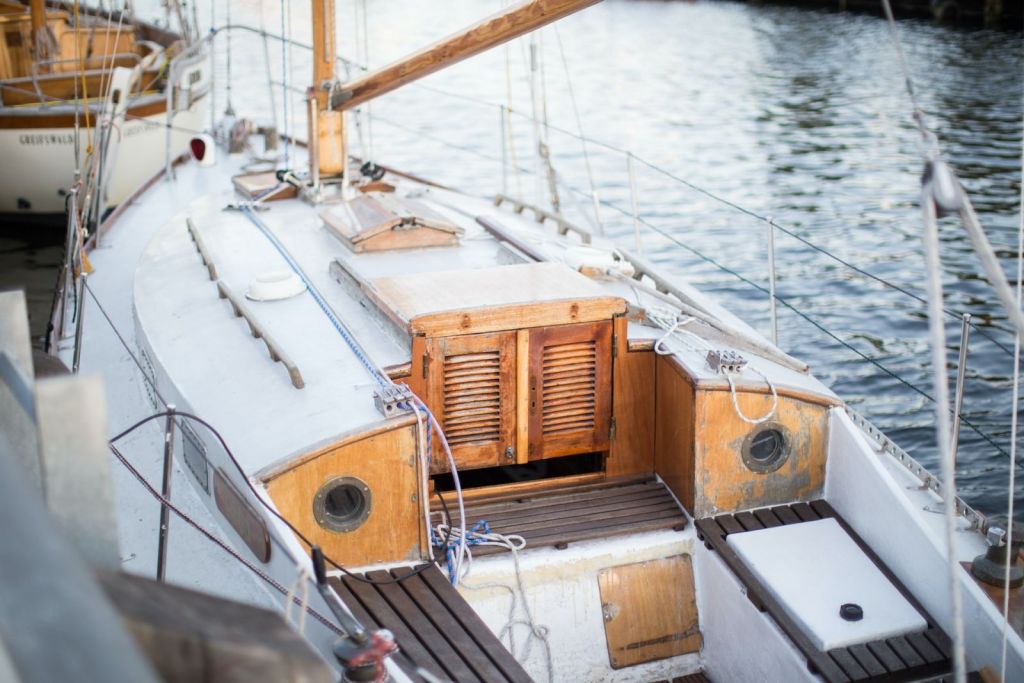

On this page:
Best beginner sailboats with cabin, let's decide on a sailboat with cabin, understand your needs when choosing a sailboat with cabin, factors to consider for your sailing needs and experience level.
| Estimated Cost | Length | Displacement | |
|---|---|---|---|
| $10,000 - $20,000 | 22 feet | 2,500 lbs | |
| $5,000 - $15,000 | 19 feet | 1,200 lbs | |
| $20,000 - $30,000 | 23 feet | 3,000 lbs | |
| $10,000 - $20,000 | 24 feet | 3,500 lbs | |
| $10,000 - $20,000 | 26 feet | 2,250 lbs | |
| $5,000 - $10,000 | 17 feet | 1,000 lbs | |
| $5,000 - $10,000 | 22 feet | 2,700 lbs | |
| $5,000 - $10,000 | 18 feet | 1,150 lbs | |
| $5,000 - $10,000 | 21 feet | 1,900 lbs | |
| $10,000 - $20,000 | 21 feet | 1,200 lbs | |
| $5,000 - $10,000 | 22 feet | 2,800 lbs | |
| $5,000 - $10,000 | 22 feet | 2,700 lbs | |
| $10,000 - $20,000 | 23 feet | 4,000 lbs |
1. Catalina 22 is a classic sailboat that has been popular for over 50 years
The Catalina 22 is an excellent choice for beginners due to its spacious cabin and easy handling. You can get it for $10,000–$20,000. You will appreciate its versatility and stability, which makes sailing more enjoyable and less intimidating. With a length of 22 feet, it's a great boat for beginners because it's easy to sail and has a comfortable cabin. It weighs 2,500 pounds.
2. West Wight Potter 19 is another good option for beginners
Your confidence will grow while sailing the West Wight Potter 19, a compact and sturdy sailboat. You can get it for $5,000–$15,000. Its compact design and shallow draft make it perfect for navigating tight spaces and shallow waters. It's a small sailboat with a cabin that's easy to handle and can be trailered. It weighs 1,200 pounds.
3. Com-Pac 23 is a larger sailboat that's still easy to handle
A great option for beginners seeking comfort is the Com-Pac 23. You can get it for $20,000–$30,000. This sailboat offers a cozy cabin and ample storage for your sailing adventures. Its stability and performance will undoubtedly enhance your sailing experience. It has a roomy cabin and is a good choice for those who want to spend longer periods of time on the water. It weighs 3,000 pounds.
4. Hunter 240 is a popular sailboat that's great for beginners
The Hunter 240 combines functionality and performance, making it an excellent beginner sailboat. You can get it for $10,000–$20,000. You will appreciate its roomy cabin and user-friendly design, which make sailing a breeze. It has a large cockpit and a comfortable cabin, making it a good choice for day sailing or weekend trips. It weighs 3,500 pounds.
5. MacGregor 26 is a versatile sailboat that can be used for both sailing and powerboating
If versatility is essential for you, the MacGregor 26 fits the bill. You can get it for $10,000–$20,000. This sailboat easily adapts to both sailing and power boating , providing you with a unique and enjoyable experience on the water. It has a roomy cabin and is a good choice for those who want to explore both the water and the land. It weighs 2,250 pounds.
6. Montgomery 17 is a small sailboat with a cabin that's easy to handle and trailer
The Montgomery 17 offers a great sailing experience for those new to the sport. You can get it for $5,000–$15,000. You'll find its compact design and easy maneuverability make it an excellent choice for building your sailing skills. It's a good choice for beginners who want a simple, no-frills sailboat. It weighs 1,000 pounds.
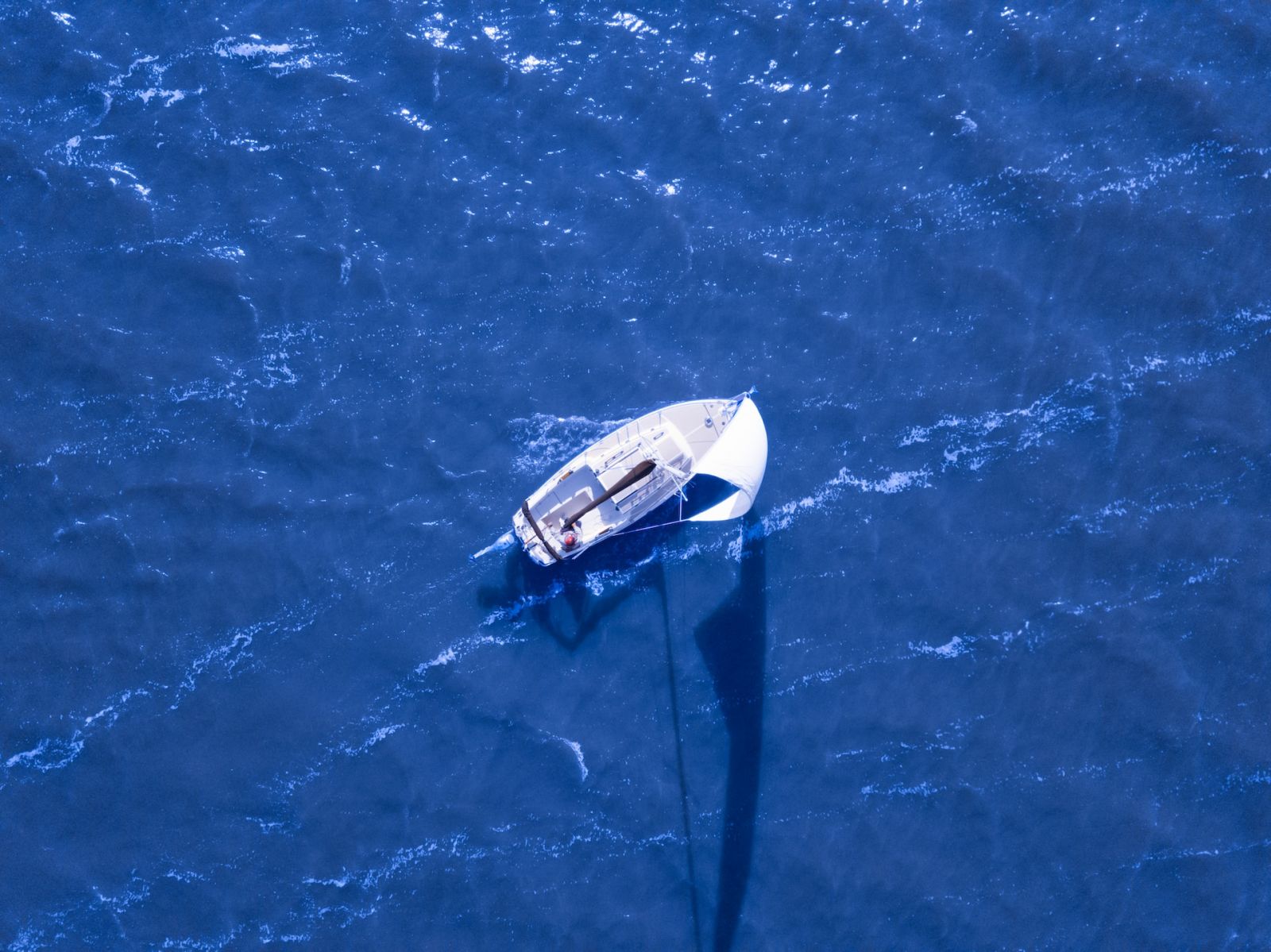
7. O'Day 22 is a classic sailboat that's easy to handle and has a comfortable cabin
Beginners will love the O'Day 22 for its simplicity and accessibility. You can get it for $5,000–$15,000. With a spacious cabin and dependable performance, this sailboat will ensure your sailing journey is smooth and enjoyable. It's a good choice for those who want to spend longer periods of time on the water. It weighs 2,700 pounds.
8. Precision 18 is a small sailboat with a cabin that's easy to handle and trailer
The Precision 18 is designed with beginners in mind. You can get it for $5,000–$15,000. You'll appreciate its manageable size and capability to navigate various sailing conditions with ease. It's a good choice for beginners who want a simple, no-frills sailboat. It weighs 1,150 pounds.
9. San Juan 21 is a popular sailboat that's great for beginners
The San Juan 21 is a fantastic option if you're just starting. You can get it for $5,000–$15,000. Its good performance and stability will allow you to develop your skills with confidence. It has a large cockpit and a comfortable cabin, making it a good choice for day sailing or weekend trips. It weighs 1,900 pounds.
10. Sea Pearl 21 is a unique sailboat that's great for beginners who want to explore shallow waters
You will love sailing the Sea Pearl 21, a beginner-friendly sailboat known for its shallow draft and stability. You can get it for $10,000–$20,000. Its compact design makes it easy to handle and perfect for weekend getaways. It has a shallow draft and a comfortable cabin, making it a good choice for those who want to spend time on the water and on the beach. It weighs 1,200 pounds.
11. Sirius 22 is a versatile sailboat that's easy to handle and has a comfortable cabin
The Sirius 22 has a comfortable cabin and user-friendly layout, which makes it an excellent choice for beginner sailors. You can get it for $5,000–$15,000. You'll enjoy sailing in various conditions thanks to its stability and performance. It's a good choice for those who want to explore both the water and the land. It weighs 2,800 pounds.
12. Tanzer 22 is a classic sailboat that's easy to handle and has a comfortable cabin
If you're looking for a beginner sailboat that's easy to handle, the Tanzer 22 is a great choice. You can get it for $5,000–$15,000. Its functional design and favorable performance make it a popular choice among novice sailors. It's a good choice for those who want to spend longer periods of time on the water. It weighs 2,700 pounds.
13. Ventura 23 is a popular sailboat for beginners that has a roomy cabin
Ventura 23 has a spacious cabin that can accommodate up to four people. You can get it for $10,000–$20,000. It's easy to handle and is a good choice for weekend trips or longer periods of time on the water. Its user-friendly features make it easy for beginners to navigate and enjoy their time on the water. It weighs 4,000 pounds.
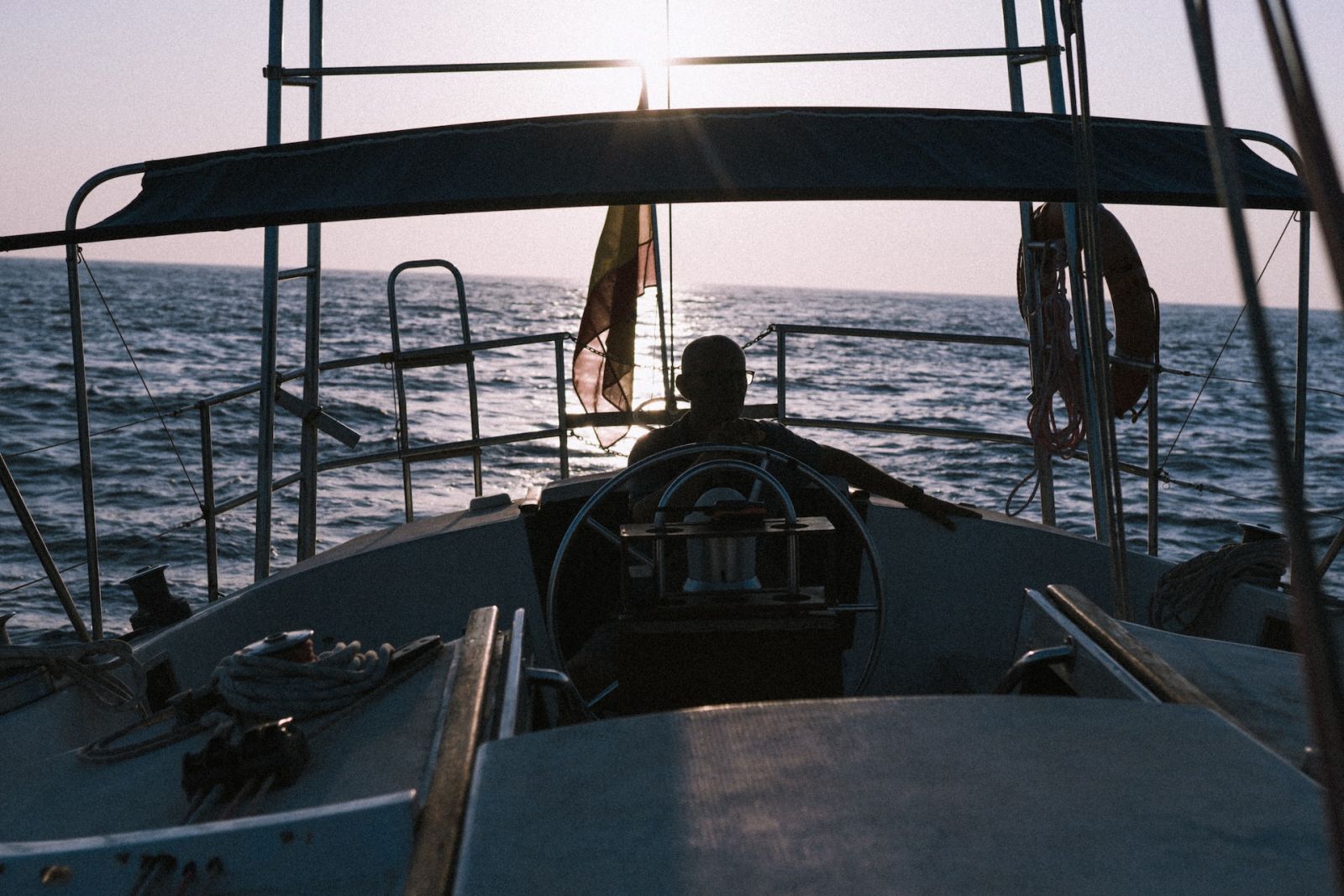
When choosing the perfect beginner sailboat with a cabin that suits your budget and needs, consider these factors:
Test sailing on a few models
This allows you to get a feel for how each boat handles and performs. Reach out to dealers or sailing clubs, as they may offer opportunities for you to try out different sailboats. Remember, your comfort and confidence on the water are crucial, so it's essential to choose a boat that feels right for you.
Research on various sailboat models
Invest some time in thorough research on various sailboat models within your budget. This will help you understand their features, strengths, and weaknesses. You can do this by consulting online resources, speaking with experienced sailors, and visiting boat shows.
Reviews from fellow sailors
Don't underestimate the power of reviews from fellow sailors. Reading the real-life experiences of others who have sailed on different boat models can provide valuable insights into their performance, maintenance, and overall satisfaction. Check out online forums, sailing magazines, and customer testimonials to gather a variety of opinions on the sailboats you're considering.
There are numerous online forums and communities dedicated to sailing enthusiasts and beginners where you can ask questions, share experiences, and learn from others who share your passion. In these spaces, you can find valuable advice and recommendations from experienced sailors on the best beginner sailboats for various purposes and budgets.
Some popular sailing forums and communities include:
- Cruisers Forum
- Sailing Anarchy
- SailNet Community
- Yachting and Boating World Forums
By participating in these communities, you'll be able to expand your knowledge, make new friends, and stay up-to-date with the latest trends and developments in the sailing world. Just remember to always approach online interactions with a friendly tone and an open-minded attitude, as this will help create a positive and supportive learning environment.
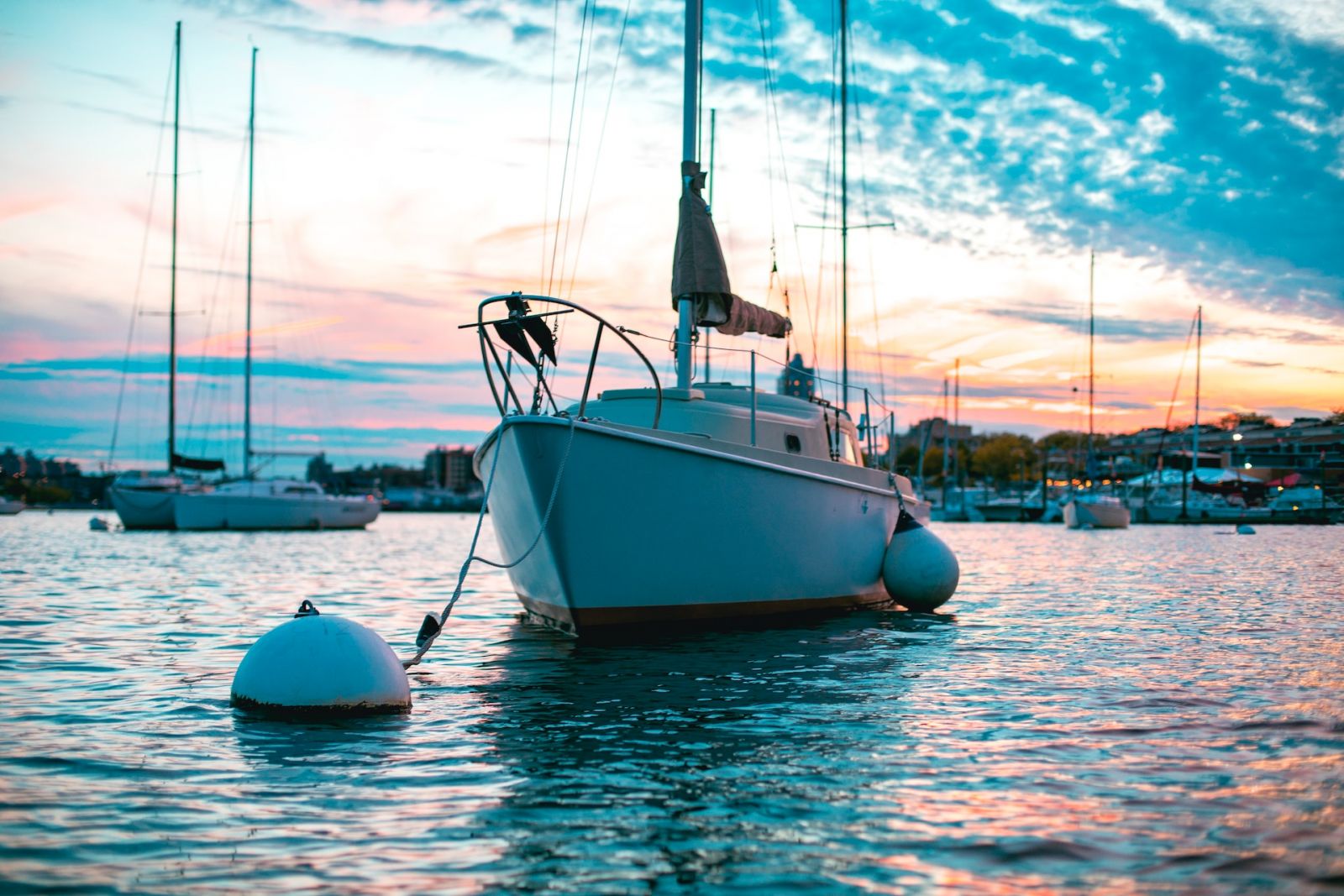
Consider the following factors to help you make the best decision that caters to your preferences and budget:
Sailing experience
As a beginner, it's crucial to choose a sailboat that matches your current skill level . Smaller boats with simple rigging and easy handling, like the Sunfish or Hobie Cats, are great for those who are just starting. As you gain experience, you may transition to larger vessels with more advanced features.
Preferred types of sailing activities
Always think about what type of sailing activities you prefer. Some people enjoy leisurely weekend trips , while others are more interested in racing. For example, the West Wight Potter is an excellent choice for weekend cruising, while the Challenger Trimaran is more performance-oriented for racers. Identifying how you plan to use your sailboat will greatly help you make the best choice for your needs.
Your budget for a sailboat with a cabin
Finding a sailboat within your budget range is essential, but also keep in mind the ongoing costs such as maintenance, mooring fees, insurance, and fuel. With realistic financial planning, you can make a wise investment in a sailboat that suits your needs and avoids future financial issues.
In this section, we will discuss the following important aspects when choosing the best beginner sailboat with a cabin: size and layout, ease of handling, and maintenance and upkeep.

Size and layout of the sailboat
The size of the sailboat is an important consideration, especially if you plan to spend nights on board or have guests join you. Choose a boat that not only fits your budget but also ensures enough space and comfort for your activities. A good starting point might be boats between 22 and 30 feet in length, offering a combination of living space, stability, and sailing capabilities.
Think about the layout of the cabin and the overall interior design. Make sure there are enough berths for everyone staying on board, and consider the placement of the galley, head, and storage areas. Keep in mind that a well-designed layout can make a small space feel larger and more comfortable.
Ease of handling the sailboat
As a beginner, it's crucial to select a sailboat that is easy to handle and maneuver. Tiller steering is a great choice for beginners, as it helps you gain a better understanding of the boat's direction and the wind's force. Look for boats with simple rigging, easy-to-reach controls, and a responsive helm. This will ensure a smoother and more enjoyable learning experience as you build your confidence in sailing.
Maintenance and upkeep of the sailboat
Owning a sailboat comes with the responsibility of regular maintenance to keep it in top shape. Familiarize yourself with the costs and tasks associated with upkeep, such as cleaning, painting, and inspecting critical components. Choose a boat with a proven history of durability and low-cost maintenance, so you don't end up dedicating all your time and money to its upkeep. Fiberglass hulls, for example, tend to be easier to maintain than wooden ones.
Duane Stallings
Who makes the “Ventura 23” that weighs 4000 lbs? I can’t find it anywhere.
Leave a comment
You may also like, sailboat parts explained: illustrated guide (with diagrams).
When you first get into sailing, there are a lot of sailboat parts to learn. Scouting for a good guide to all the parts, I couldn't find any, so I wrote one myself.
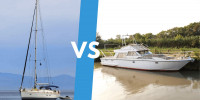
Sailboat vs. Powerboat: What's the Best Liveaboard?
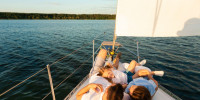
Choosing the Best Family Sailboat (Tips by Expert)
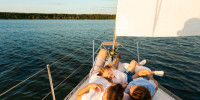
13 Best Liveaboard Sailboats (under 30 & 50 ft)

41 Sailboat Cruising Essentials for Long Trips
DIY Boat Building Plans
How To Build A Boat Cabin
Download over 500 Boat Plans. Click on the link below.
-->click here<--.
Table of Contents
Overview of How To Build A Boat Cabin
When it comes to building a boat cabin, the first step is to determine the design and layout that best suits your needs and the size of your boat . Assessing your boat’s dimensions is crucial in this process, as it will help you determine the optimal cabin size and configuration. Consider the intended use of the cabin, whether it’s for sleeping, storage, or living space, as this will guide your design decisions. Sketching out different cabin layouts can be a helpful exercise to find the best fit for your boat and requirements. Experiment with various configurations, such as a single-berth cabin, a dinette-style layout, or a more open-concept design. This will allow you to visualize the space and identify the most efficient and practical arrangement. It’s also essential to ensure that your cabin design complies with any local regulations or safety requirements. This may include considerations such as emergency exits, ventilation, and accessibility. Consulting with local authorities or experienced boat builders can help you navigate these guidelines and ensure your cabin meets the necessary standards.
Key Takeaways
- Determine the cabin design and layout before gathering materials and tools .
- Construct the cabin frame and install walls, ceiling, windows, doors, and ventilation.
- Insulate the cabin for comfort and finish the interior with furnishings.
- Weatherproof the cabin exterior to protect against the elements.
- Test and refine the boat cabin to ensure it meets your needs and expectations.
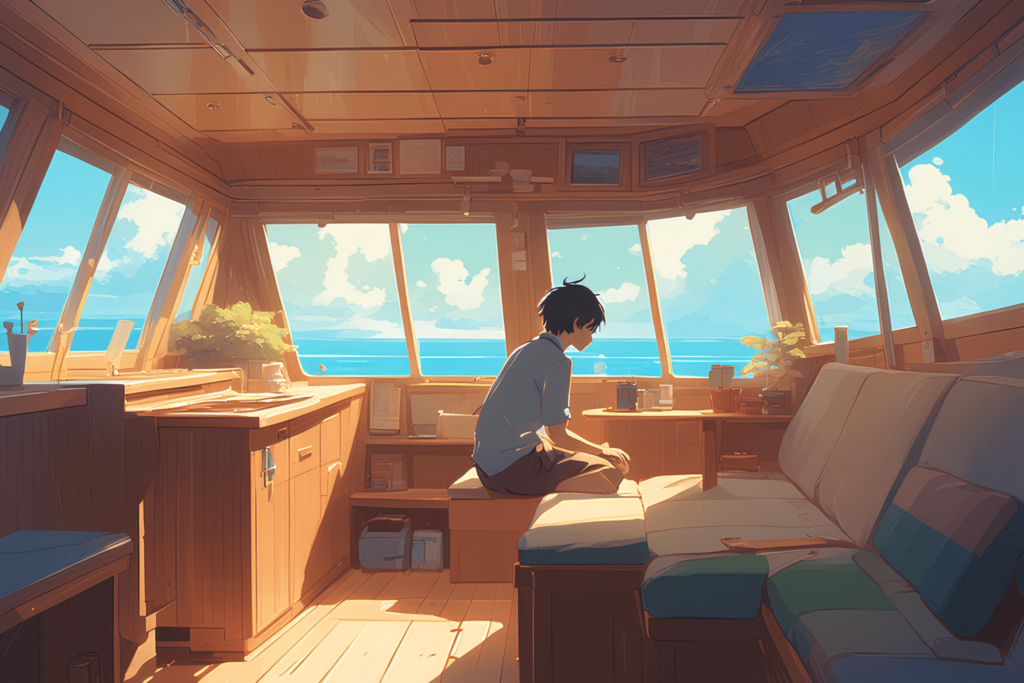
Gather the Necessary Materials and Tools
Constructing a boat cabin requires a comprehensive list of materials and a well-equipped set of tools. Begin by compiling a detailed list of the lumber, plywood , insulation, hardware, and finishes needed for the project. Investing in high-quality tools, such as a circular saw, power drill, and measuring devices, will make the construction process more efficient and precise. Ensure that you have access to a workspace large enough to accommodate the cabin construction. This may involve renting or borrowing a suitable space, depending on the size of your boat and the complexity of the project. Additionally, consider the need for specialized tools, such as a table saw or a router, and plan to rent or borrow them if necessary. Having the right materials and tools on hand will not only streamline the construction process but also help you achieve a professional-looking and durable cabin. Take the time to carefully plan and prepare your workspace to ensure a smooth and successful build.
Construct the Cabin Frame
The foundation of a well-built boat cabin is the frame. Begin by constructing the base, ensuring it is sturdy and level to support the entire structure. This may involve building a platform or a series of supports that can be securely attached to your boat’s deck or hull . Next, erect the vertical walls of the cabin frame. Utilize bracing and supports to maintain the frame’s integrity and prevent any warping or sagging. Pay close attention to the alignment and stability of the walls, as this will be crucial for the overall structural integrity of the cabin. The final step in constructing the frame is to build the roof. Consider factors such as the desired pitch, overhang, and ventilation requirements when designing the roof structure. Secure the frame components using appropriate fasteners and techniques, ensuring a solid and stable foundation for the rest of the cabin construction. Throughout the framing process, it’s essential to maintain a high level of precision and attention to detail. A well-constructed frame will provide a solid foundation for the rest of the cabin, ensuring its long-term durability and functionality.
Install the Cabin Walls and Ceiling
With the cabin frame in place, it’s time to focus on the walls and ceiling. Measure and cut the plywood or other wall materials to fit the frame seamlessly. Carefully attach the wall panels, ensuring a tight and secure fit to prevent any leaks or drafts. The installation of the ceiling is equally important. Consider the placement of any lighting or ventilation fixtures, and plan accordingly. Secure the ceiling panels, creating a weathertight enclosure that will protect the cabin’s interior from the elements. Sealing all seams and joints is crucial at this stage. Use high-quality sealants and caulk to create a watertight barrier, preventing water intrusion and maintaining the cabin’s structural integrity. This attention to detail will pay dividends in the long run, ensuring the cabin’s longevity and performance. Throughout the wall and ceiling installation process, maintain a keen eye for quality and precision. A well-executed cabin interior will not only enhance the overall aesthetic but also contribute to the cabin’s functionality and comfort.
Add Windows, Doors, and Ventilation
| Materials | Cost | Time |
|---|---|---|
| Marine-grade plywood | 100 | 2 days |
| insulation | 50 | 1 day |
| Marine carpet | 75 | 1 day |
| LED lights | 30 | 1 day |
| Marine-grade paint | 50 | 2 days |
Incorporating windows, doors, and ventilation systems into the cabin design is a crucial step in creating a comfortable and livable space. Carefully measure and cut the openings for these features, ensuring a precise fit that will prevent any leaks or drafts. Install the windows and doors, sealing them properly to maintain the cabin’s weathertightness. Consider the placement and orientation of these elements to optimize natural lighting, airflow, and visibility. Ventilation is equally important, as it helps to prevent the buildup of condensation and maintain a comfortable indoor environment. Incorporate hatches, vents, or other ventilation systems to ensure adequate airflow and circulation. For added functionality and aesthetic appeal, you may also consider incorporating additional features, such as skylights or portholes. These elements can enhance the cabin’s natural lighting and create a more open and airy feel. Throughout the process of adding windows, doors, and ventilation, pay close attention to the details and ensure that all components are properly sealed and integrated into the cabin’s overall design.
Insulate the Cabin for Comfort
Ensuring the cabin is properly insulated is essential for maintaining a comfortable and energy-efficient living space. Evaluate the climate and weather conditions your boat will encounter to determine the appropriate insulation materials and R-value. Carefully install the insulation, filling all cavities and gaps to maximize its effectiveness. Consider using a combination of insulation types, such as rigid foam panels and fiberglass batts, to achieve optimal thermal and acoustic performance. Sealing any potential air leaks around windows, doors, and other openings is crucial to maintaining the cabin’s insulation efficiency. This will help to prevent heat loss or unwanted air infiltration, contributing to the overall comfort and energy efficiency of the cabin. Proper insulation not only enhances the cabin’s livability but also helps to protect the boat’s structure from the elements. By creating a well-insulated and weathertight enclosure, you can ensure the long-term durability and performance of your boat cabin.
Finish the Interior with Furnishings
With the cabin’s structure and insulation in place, it’s time to focus on the interior finishes and furnishings. Choose durable and lightweight materials, such as marine-grade plywood or paneling, to create a cohesive and visually appealing interior. Install cabinetry, shelves, and other storage solutions to maximize the cabin’s functionality and organization. Carefully plan the placement of these elements to ensure efficient use of the available space. Select comfortable and practical seating, bedding, and other furnishings to create a cozy and inviting living space. Consider the intended use of the cabin and choose furnishings that will enhance the overall livability and enjoyment of the space. Incorporate lighting fixtures, electrical outlets, and other amenities to improve the cabin’s functionality and convenience. Thoughtful placement and selection of these features will contribute to the overall comfort and usability of the cabin. The interior finishes and furnishings are the final touches that will transform the cabin from a functional structure into a welcoming and personalized living space. Attention to detail and a focus on both form and function will result in a boat cabin that meets your needs and exceeds your expectations.
Weatherproof the Cabin Exterior
Protecting the cabin’s exterior from the elements is crucial for its long-term durability and performance. Begin by applying a high-quality sealant or paint to the cabin’s exterior, creating a barrier against water, wind, and UV radiation. Ensure that all joints, seams, and openings are properly sealed to prevent water intrusion and maintain the cabin’s structural integrity. This may involve the use of specialized sealants, caulks, or gaskets to create a watertight seal. Consider adding additional weather-resistant features, such as a canvas or fiberglass cover, to further protect the cabin from the elements. These coverings can shield the cabin from direct exposure to rain, snow, and intense sunlight, extending its lifespan and preserving its appearance. Regularly inspect and maintain the cabin’s exterior to address any wear or damage that may occur over time. Addressing issues promptly will help to ensure the cabin’s long-term durability and performance, allowing you to enjoy your boat’s amenities for years to come.
Test and Refine the Boat Cabin
The final step in the boat cabin construction process is to thoroughly test and refine the design. Conduct a series of tests to evaluate the cabin’s functionality, including its structural stability, water tightness, and ventilation. Identify any areas that require additional attention or refinement, and make the necessary adjustments. This may involve fine-tuning the cabin’s layout, modifying the insulation, or addressing any leaks or drafts. Gather feedback from family or friends who have used the cabin to gain valuable insights and identify opportunities for improvement. Their perspectives can help you identify aspects of the cabin that may need further refinement or customization. Continuously monitor the cabin’s performance and make any necessary modifications to ensure it meets your needs and expectations. This ongoing process of testing and refinement will help you create a boat cabin that is not only well-built but also tailored to your specific requirements and preferences. By taking the time to thoroughly test and refine the cabin, you can be confident that your investment of time and effort will result in a functional, comfortable, and durable living space that enhances your boating experience for years to come.
Conclusion – How To Build A Boat Cabin
We hope that this article has helped you learn how to build a boat cabin. Building a boat cabin is a rewarding and enjoyable project that can enhance your boating experience. By following the steps and tips that we have provided in this article, you can build a boat cabin that is durable, functional, and attractive.
FAQs – How To Build A Boat Cabin
What is a boat cabin.
A boat cabin is an enclosed space on a boat that provides shelter, storage, and living quarters for the crew and passengers.
What materials are commonly used to build a boat cabin?
Common materials used to build a boat cabin include wood, fiberglass, aluminum , and steel.
What tools are needed to build a boat cabin?
Tools needed to build a boat cabin include a saw, drill, hammer, screwdriver, measuring tape, level, and various other hand and power tools.
What are the basic steps to building a boat cabin?
The basic steps to building a boat cabin include designing the cabin, selecting materials, measuring and cutting the materials, assembling the cabin, and finishing the cabin with paint or other coatings.
What are some important considerations when building a boat cabin?
Important considerations when building a boat cabin include ensuring the cabin is watertight, structurally sound, and properly ventilated. It is also important to consider the weight distribution of the boat and the cabin’s impact on the boat’s stability.
Can a boat cabin be built by someone with no prior experience?
While it is possible for someone with no prior experience to build a boat cabin, it is recommended that they seek guidance from experienced boat builders or take a boat building course to ensure the cabin is built safely and correctly.
Written by DIY Boat Building Plans

How To Build a Boat Bench Seat

How To Build a Boat Cradle
- For Sale/Wanted
- Readers Tips
- Your Yarns.
- Restoration
- Miscellaneous
- DIY Boat Yards
- Boat Building
- Cabin Cruisers
- Free Boat Plans
- Begin Boating
- Boating Terms
- Ropes and Rigs
- Just for Fun
- Celestial Navigation
- Passage Planning
- VHF Marine Radio
- Diagonal Scale
Sailboat Plans
Free Sailboat Plans
A selection of some of the Free Sailboat Plans (pdf) that were published in magazines such as “Popular Mechanics”, "Popular Science" and the "Boat Builder Handbook".
If you need help with lofting out the plans click here for an article here which should help.
- Open Dayboats/Dinghys
- Rowing Boats
Open/Dayboat, Free Sailboat Plans
Everyone who digs boating has heard of the Hobie Cat, the sleek little catamaran that burst on the scene and captured the attention of all the fast-action sailors.
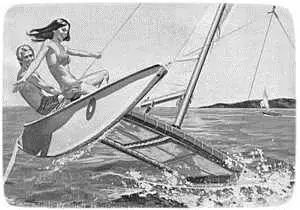
Marked by asymmetrical hulls and special trampoline supports, the Hobie can reach speeds above 20 mph and perform with a rare agility.
But it has one drawback.
It costs mucho dinero.
Thus, we introduce the Hobby Kat, sailboat plans, a build-it-yourself version of the “Hobie” that should cost from half to a third of the commercial version. If you have the moola, of course, go for a Hobie and have the time of your life on the water.
If not, try our Hobby
The homebuilt is not quite the same.
But she sails sweetly and fast—qualities which have made the “Hobie” popular
Even in a light air she’ll slip through the water at a fast clip.
She has no centreboards, leeboards or keel, and needs none.
The inside of each hull has built-in lift, like an airplane wing, so that as the boat heels and one hull digs in the boat is pulled back to windward.
Click Here for the Plans
She can run in very shallow water and the rudders kick up for beaching.
You can carry her on a trailer or even disassemble her.
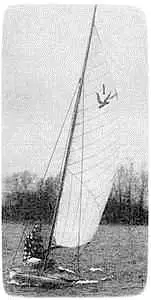
Many a “stink pot” addict will take a second look at Tern because she planes in modest breezes, is easy to handle, and her streamlined prow arid pod-shaped, “inland scow” type hull offer slight water resistance. Then too, there’s a charm about the tiller of a sailer that’s not matched by the wheel of a motor-powered boat. Part of it is the challenge of making the most of nature’s free-wheeling breezes. Even with her 72sq.ft of sail, this Free Sailboat Plan is remarkably stable, and packs as many as four persons aboard
For thousands of inland lakes, Tern is the answer to sailing water sport, she is rugged and easy to launch
And she’s remarkably easy to build.
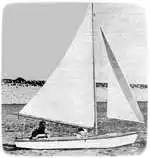
Falcon is a small, speedy, sporty sailboat which handles well. Tests on the original Falcon showed that she could easily out-distance boats of comparable size such as the one design class Snipe and Comet sailers.
And she will pace neck and neck with 18 footers with considerably greater sail spread.
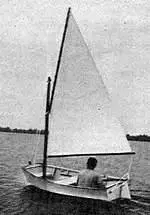
This strong, beamy, eight-foot pram may be sailed either cat-rigged or sloop-rigged.
The dagger-board may be adjusted forward to balance the helm when sailing with the addition of a jib sail.
Oars or a small outboard motor may also be used to power this versatile Free Sailboat Plans.
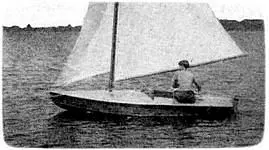
Dart” is a small two or three person sailing craft, designed for use on protected waters such as bays. lakes, rivers or wherever sheltered waters are found. Its construction will repay the builder handsomely and provide a fast sailing craft, light in weight, easily transportable and cheap to construct with all difficult joinery eliminated
It provides thrilling and economical sport.
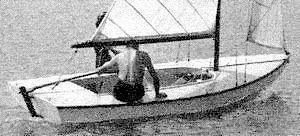
The 'Crescent', designed by C. T. Allen, is the ideal sailboat for day sailing on a small lake, river, or protected waters of a bay.
Centreboard design (Fig. 2) reduces Crescent's draft, so Shallow is not a problem.
Its broad beam of over 5½ft. makes it an ideal family boat because there is room for a cockpit large enough to accommodate four adults or two adults and three kids, and side and forward decks big enough to stretch out on when sun bathing.
"Jewel" is a 16' Crescent Sailboat being built by Mike Allen from the free sailboat plans by C.T .Allen in the 1958 "Boat Builders Handbook". And what a superb job Mike is doing check out his photos here .
Click Here for the Free version of the Plans
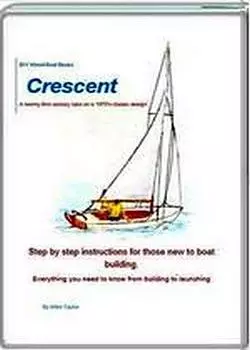
Sailing enthusiasts and backyard boat builders are not likely to find free boat plans for a sailing pram that can be built faster, lighter, stronger, or less expensively than Graefin-10. Two men can begin work on a Friday evening and have a smart, lively 10-ft. 85-pound sailboat in the water by Sunday evening (it’s been done).
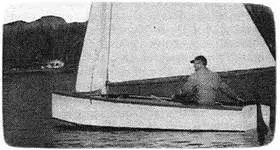
Zephyr Is a refinement of a type of boat developed by the English for use in the rough open waters of the English Channel. Not only is it fast under sail, but it can stand up under punishment. And it’s light enough to be easily loaded atop an auto or light trailer.
Breeze-Baby
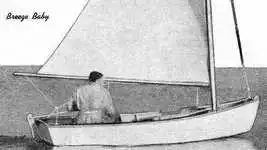
Skimming off a brisk wind or with the wind abeam, Breeze-Baby actually planes with one person aboard. Despite her rowboat lines that make her easy to build, she handles easily under her simple sail, an ideal first boat. Simple lines are adapted to plywood construction that’s strong, light and that keeps Breeze-Baby’s bilges dry
You can take her with you atop your car or on a lightweight trailer for summer fun wherever you vacation or get in a week-end’s sailing.
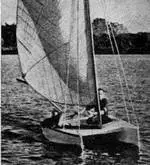
Cat’s Paw is easy to build because of the straight-sided hulls. The sheer line is flat and that simplifies building the form. Bow and stern are straight, so there’s no cockeyed bevel to fit and fuss with
She Is an Ideal boat to learn or practice sailing in because she will forgive so many mistakes.
Cabin Cruiser, Free Sailboat Plans
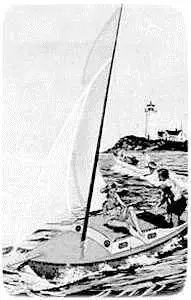
Previous posts
See What Others Have Posted

Recent Articles
Boat Winches
Jun 21, 24 04:18 AM
- Boat Plan Books
- Boatbuilding Tips
- Glass Cloth
- Stitch and Glue
- Strip Plank
You might like these

Knotty wood, problems with boat building timber.
Knotty wood, how to avoid structural problems with knots in lumber when using softwood timber for fitting out and boat joinery

Build a Boat, tips for the DIY Wooden Boat Builder.
How to Build a Boat, Wooden Boat Building methods for the DIY, backyard, self-builders explained, carvel, lapstrake and plywood

Wood Screws for Boat Building and Repair.
Wood Screws are the most widely used and versatile fasteners used on wooden boats. Which type to use and how to use them

Wood, Environmentally Friendly Boat Building Lumber.
Make sure that the Wood that you buy and use is sustainably grown and harvested.
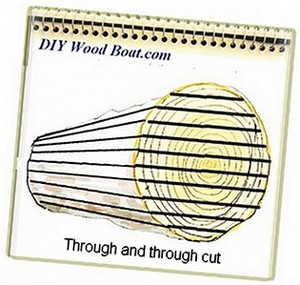
Timber, Lumber for Boat Building.
A brief description of the most common Timber used for building Wooden Boats how to choose wood for your project boat

Timber Properties
A brief guide to timber properties and wood, characteristics such as strength, stiffness and elasticity for choosing lumber for wooden boat building and restoration.
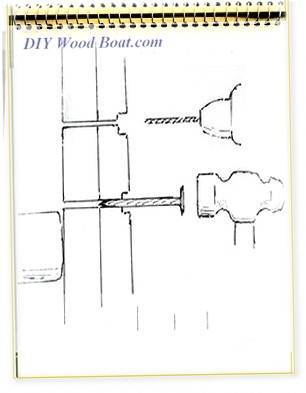
Rivets and Copper Rove Wood Boat Fastenings.
How to use Copper Rivets and Roves construction guide to fasteners on your wooden boat.

Ring Nails for Marine Fastening.
Ring Nails sometimes call Gripfast or ring shank, silicon bronze boat nails are renowned for their holding power. but how to get them out?

Plywood and Veneer Guide for Marine use.
A guide to plywood for boat building and why you should use the best marine grade you can afford.

Glue for Wooden Boat Building
Which Wood Glue to use when building or restoring a wooden boat, resorcinol to epoxy.

Rowing Boat Plans
Free Rowing Boat Plans for the backyard home builder, build your own rowing boat, dory, folding dinghy or pram using these simple plywood designs.

Free Motorboat Plans
Free Motorboat Plans for the backyard home builder, build your own speed boat, cabin cruiser, runabout or utility boat using these simple plywood designs.
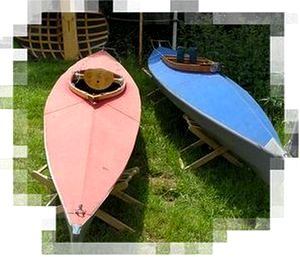
Wooden Boat Kits.
Wooden boat building is easy and inexpensive with wooden boat kits. From row boats and kayaks to sailing cruisers, boat to be proud of

Supplies for Wooden Boat building and Maintenance
Supplies for Wooden Boat Building and restoration, how to choose the materials and marine chandlery for your project.

Small Boats, Made of Wood
What Everybody ought to know about building Small Boats, guidance and tips for self-building or restoring.
Owens Boats
Jun 05, 24 12:14 PM
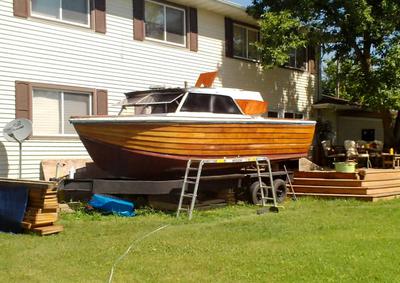
Penn Yan Boats
May 28, 24 07:51 AM
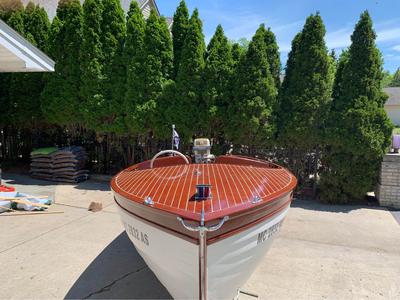
Wooden Boat Restoration, Repair and Maintainence.
Wooden boat restoration, how to fix up an old wooden boat, one of the cheapest ways to get afloat and have a boat to be proud of.

Epoxy Resin for DIY Wooden Boat Building.
A guide to the epoxy resins and sustainable enrtopy resins to use when building wooden boats with marine plywood.

Wood Rot Repair and Treatment
Wood rot in wooden boats, how to treat, repair and replace rotten timbers in a wooden boat
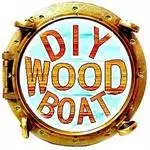
Privacy Policy
Advertising Policy
Cookie Policy

I am perfectly aware that the majority of Wooden Boat aficionados are sensible folk. However, I need to point out that I am an amateur wooden boat enthusiast simply writing in order to try to help other amateur wooden boat enthusiasts. And while I take every care to ensure that the information in DIY Wood Boat.com is correct, anyone acting on the information on this website does so at their own risk.
Attainable Adventure Cruising
The Offshore Voyaging Reference Site

- Sailboat Deck Layouts
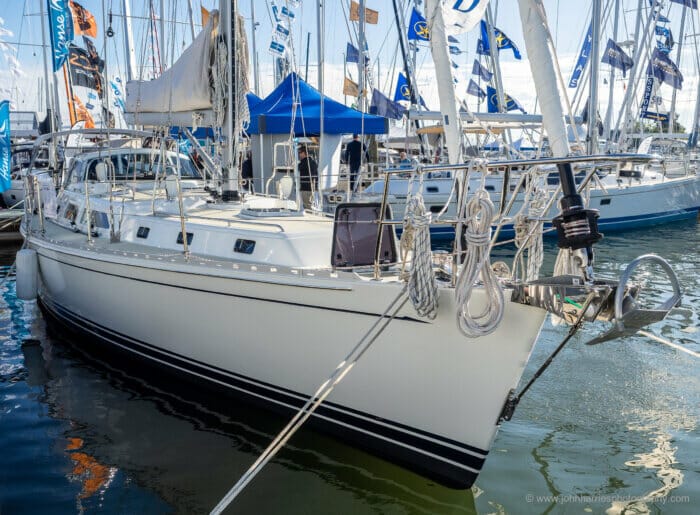
I’m going to use the Outbound 46 as a base to write about optimal deck layouts for sailboats. Information that will help anyone to either select a good deck layout when buying a boat, or fix a screwed-up one on a boat they already have.
Good Deck Layouts Are Rare
That last sentence may surprise many since it would be logical to expect cruising sailboats to have good and functional deck layouts, but as an ex-sailmaker and longterm racer, the thing that never ceases to amaze me is that most boats, particularly those marketed as cruisers, come out of the yard with the rig and deck gear set up so poorly that actually sailing them is nothing but a huge chore, and it takes years for even a knowledgeable owner to sort things out—just read Colin’s trials and tribulations with the rig on his Ovni 435 to see what I mean.
This is so bad that I’m pretty sure that the popularity of in-mast and in-boom mainsail furling systems is in large part because most boats are so poorly set up for reefing that owners have been scared off simple and robust systems and toward complex, fragile, and expensive ones.
I will also write, once more, about speed. I know, we are cruisers, so why do we care? Well, up to you, but to me if we are going to really cruise under sail, rather than just motor around with an oversized flag pole and occasionally unroll a sail attached to it as we see so often these days, we might as well do it properly.
Seriously, a well set-up boat, efficiently reeling off the miles under wind power alone, is one of life’s sublime pleasures, and knowing that we can control the rig and shorten sail quickly and efficiently without automation or brute strength is the cherry on top.
Let’s look at how to do that:
Login to continue reading (scroll down)
Please Share a Link:
More Articles From Online Book: Sail Handling and Rigging Made Easy:
- Six Reasons To Leave The Cockpit Often
- Don’t Forget About The Sails
- Your Mainsail Is Your Friend
- Hoisting the Mainsail Made Easy—Simplicity in Action
- Reefs: How Many and How Deep
- Reefing Made Easy
- Reefing From The Cockpit 2.0—Thinking Things Through
- Reefing Questions and Answers
- A Dangerous Myth about Reefing
- Mainsail Handling Made Easy with Lazyjacks
- Topping Lift Tips and a Hack
- 12 Reasons The Cutter Is A Great Offshore Voyaging Rig
- Cutter Rig—Should You Buy or Convert?
- Cutter Rig—Optimizing and/or Converting
- Cruising Rigs—Sloop, Cutter, or Solent?
- The Case For Roller-Furling Headsails
- The Case For Hank On Headsails
- UV Protection For Roller Furling Sails
- In-Mast, In-Boom, or Slab Reefing—Convenience and Reliability
- In-Mast, In-Boom, or Slab Reefing —Performance, Cost and Safety
- Making Life Easier—Roller Reefing/Furling
- Making Life Easier—Storm Jib
- Swept-Back Spreaders—We Just Don’t Get It!
- Q&A: Staysail Stay: Roller Furling And Fixed Vs Hanks And Removable
- Rigid Vangs
- Rigging a Proper Preventer, Part 1
- Amidships “Preventers”—A Bad Idea That Can Kill
- Rigging a Proper Preventer—Part 2
- Downwind Sailing, Tips and Tricks
- Downwind Sailing—Poling Out The Jib
- Setting and Striking a Spinnaker Made Easy and Safe
- Ten Tips To Fix Weather Helm
- Running Rigging Recommendations—Part 1
- Running Rigging Recommendations—Part 2
- Two Dangerous Rigging Mistakes
- Rig Tuning, Part 1—Preparation
- Rig Tuning, Part 2—Understanding Rake and Bend
- Rig Tuning, Part 3—6 Steps to a Great Tune
- Rig Tuning, Part 4—Mast Blocking, Stay Tension, and Spreaders
- Rig Tuning, Part 5—Sailing Tune
- 12 Great Rigging Hacks
- 9 Tips To Make Unstepping a Sailboat Mast Easier
- Cruising Sailboat Spar Inspection
- Cruising Sailboat Standing Rigging Inspection
- Cruising Sailboat Running Rigging Inspection
- Cruising Sailboat Rig Wiring and Lighting Inspection
- Cruising Sailboat Roller Furler and Track Inspection
- Download Cruising Sailboat Rig Checklist
Hi John I could not agree with you more about how frequently boats with conventional mains are poorly set up for easy reefing and eventual dousing. It is another area where the maritime media/boatbuilders etc. have dropped the ball at educating owners how best to have their boat set up. Too many sailors (and their crew) get put off by a poor and difficult reefing set-up which likely means they have put off reefing and been over-canvased needlessly: always a lousy thing. Enough of that and they are buying a cabin in New Hampshire. I urge those looking at in-mast or in-boom furling to consider that reefing and dousing the main can be easy and fairly fast and with a minimum of effort on a boat that is well set up for it. I then enumerate the myriad down-sides of particularly, in-mast reefing/furling and the benefits of a conventionally rigged main. I am in no way a speed demon, but I like to sail and I like to sail well. You mention sublime pleasure in cranking out miles: my sublime pleasure often comes at watching superbly shaped sails at work; especially when in challenging weather, the third reef is in and working and that small sail is perfectly shaped to do its job and as bulletproof in functioning as can be devised. My best, Dick Stevenson, s/v Alchemy
I agree completely, particularly on the pleasure of looking at really good mainsail shape when reefed.
Hi John, I totally get your “simplicity” approach and at mast mainsail handling preference. It just wouldn’t work for us and I suspect for many other cruising couples. I think I can see at least one hatch in the Outbound 46 hard-dodger top, which means adjusting the halyard / reefing lines and setting the mainsail / twist, should be simple enough from the cockpit, if (big “IF” I know) the reefing lines are well set-up. And I personally like this set-up for short-handing. Our safety process requires a second crew to be in support, if someone leaves the cockpit (day or night, coastal or offshore). I would guess we could reef / shakeout a reef on the Outbound 46, without calling the off-watch crew – a real-plus in our book as we mostly sail two-up. Our first mate would not cruise with me if I left the cockpit every time we needed to take a reef in rough conditions. It’s that simple. And if something happened to me, there is no way she would go forward to the mast and handle the sail on her own. Whereas she can, and does, reef single handedly on our boat, and I would guess she could on the Outbound 46 set-up, which is almost identical to our boat – the difference is we have in-boom furling which simplifies operations further. Likewise, the outbound 46 set-up would be easy and safe to hoist / lower / reef the mainsail when single-handing. I see so many single-handing yachts sailing just with their headsails, I suspect because on-mast mainsail handling leaves no one in the cockpit, if something happens. I often single hand our yacht with no loss of efficiency and really enjoy it. Br. Rob
I just can’t see that twisting ones head to look up out of a small hatch to see the mainsail while simultaneously grinding a winch and operating clutches is ever going to provide the visibility and situation awareness of looking directly at the part of the sail you are tensioning while standing at the mast while right next to the luff where any hang ups can be quickly seen and dealt with. So yes, for sail trim the hatches may help a bit, but not for reefing. Also at night on the Outbound a headlamp will reflect off the hatch glass making visibility of the main effectively zero.
I agree that being able to reef and shake out without calling the off watch is vital, but we do that fine at the mast too. Phyllis and I are also not fans of the idea of calling the off watch every time someone leaves the cockpit since we feel that the disruption of rest outweighs and added benefit of so doing.
I guess that relates to our basic thinking that the deck, particularly as far as the mast is not an intrinsically hazardous place to be avoided, but simply part of the working area of the boat, just as the cockpit is. We feel that regularly visiting the mast in all weathers is vital since it will be required anyway for functions like setting a proper preventer, setting the pole, and moving the runners forward, not to speak of clearing any kind of SNAFU.
We also differ in that we evaluated in boom furling/reefing and rejected it as too fragile, difficult to fix at sea, and expensive for our needs. That was based on experience in that the boat I did was on for six weeks as guide on a trip to Greenland had one.
So, in summary, I guess we just see things in a fundamentally different way.
Like you I mostly sail singlehanded or effectively singlehanded and I don’t really regard going forward in a rising wind as a pleasurable experience, especially in the dark. I’d like to add granny bars at the mast but worry that they would be extra deck clutter and spoil “the look”. But I’ve got to say I’m with John on this one. There’s quite enough string in the cockpit already without adding seven more bits. And, while in boom furling does look attractive, for me its too reminiscent of the appalling old rotating boom mainsail furling system I had on my first yacht, a Folkboat. The sail shape one got on that in any but perfect conditions was sad to see.
The sailor who puts in an early reef is a happy sailor. And probably longer living. How often is one surprised at the improved performance that results from under-pressing the rig ? And, while there is a lot that can lengthen the time at the mast putting in a reef, shaking an unnecessary one out really is a matter of seconds.
In defence of modern in boom furling, the set is way better than it was in the bad old days of roller reefing mainsails. That said, my big problem with them is complexity and fragility. Probably fine for inshore sailing where if they break you can just take the main down and head for somewhere to wait for parts and with smooth water where you can fix it, but I would never take one offshore, and particularly not to the high latitudes. All this based on taking a yacht to Greenland with one.
I own a Outbound 46 hull#50. Would add the following. The hydraulic backstay is quite helpful reefing the Genoa. Put tension on that stay and she rolls up more easily. Unless you tune the rig with more tension on the solent stay then the Genoa stay when the backstay is untensioned you get headstay sag on the solent. You lose nothing upwind using the solent instead of the Genoa going upwind so the need to roll up the Genoa before tacking is a non issue as it ends up being a reaching or running sail. We stand single watches. I love having both the primaries (powered) and the headsail reefing lines an arms length away from the wheel. I can reef under control, by myself with no engine nor AP. Then go forward and deal with reefing the main. I can do it under Hydrovane. Not needing to bring anybody up from below is wonderful. I hate single line reefing on any boat. It better than in boom or in mast but not by much. If done get a Dutchman as well. That makes it easier to inch the main down and have both ends of the sail tension correctly as you can see what’s going on and the sail has no choice but to fold correctly. Outbound come single for first two and double for the third. Would think to get just two very deep reefs and make both double. I have the survey being done on Tuesday. Then she’s gone as we transition to a Norhavn. The Outbound is the best mom and pop blue water cruising boat there is imho.
I too am not a fan of single line reefing so I think your recommendation to go with two deef reefs each with two separate reefing lines would be a good one.
That’s how we went, but then as a comparatively heavy motorsailer, we tend to leave the full main up a little longer than some just to make the boat go. We have separate reefing lines, as well and have all halyards and related lines at the mast. We have preventers, staysail sheets, yankee jib sheets and occasionally, spinnaker sheets back to the winches (three pairs) in the aft cockpit position, where there is also end-boom mainsheeting (6:1) and a strong Garhauer traveller (3:1). Works for us to date. I have over the years become a touch suspicious about “convenience” unless the sea first makes its case.
I agree was many of your points and know by your article I am not going to convince you, but we love being able to put in and take out reefs in from the cockpit. We can easily put a reef in or shake a reef out in less than a minute on our 37 foot cruising boat. I have read Colin’s article and I think a single line for each reef is way too much friction. We use a second line to pull the tack into the right position at the goose neck. These lines on our boat are only 5/16. Each one is led from the reefing hook, through the reef tack crinkle to a carefully placed bullseye on the mast, through a pulley at the mast base and then back to a harken cam cleat next to my jammers. You never need to put this on a winch – the idea is to get the bullseye position such that you end up with the reef crinkle pulled into the goose neck at just the right position when the halyard is re-tensioned. The clew end is conventional – from a bowline positioned about 6 inches aft of where you could stretch out the foot of the sail at the reef point up through the reef clew cringle to pulleys at each end of the boom through a good block at the base of the mast and then to a jammer and winch at the cockpit. When putting in a reef we pull down on the tack line while easing the halyard. Don’t allow slack in the halyard – the jammer is cast off but the halyard is restrained by hand with a single turn around the winch. 2 or 3 times we will pause in this operation by locking the halyard jammer and pulling the slack out of all the other tack and clew reefing lines by hand. We have found that this is the secret to being able to complete the whole operation from the cockpit since minimizing slack loops prevents them getting caught up anywhere. We continue until the halyard is just past a mark on the halyard line and then put the tack line in the cam cleat. At night we shine a flashlight on the tack to make sure it is neatly pulled into the gooseneck and then tension the halyard on the winch. Once again take the time to take all the slack out of the other reef lines by hand. Put the clew reefing line on a winch and crank until you are happy with the foot and leach tension – you need to check this with a flashlight at night.
Our reefs can be put in in way less time than it takes to write about it quickly and safely from the cockpit without even having to put your jacket on. Because we can put in or shake out reefs in the main easily we do not procrastinate for a moment about reducing or increasing mainsail. Our record is 11 changes in a single 3 hour shift as a series or 20 minute squalls rolled through at night close to the equator on a passage from San Francisco to the Marquesas and the lone watchkeeper was busier than a one armed paper hanger reacting as the wind went up and down from 8 to 30 knots!
Sounds like a good system. And I agree that taking the slack out of the non-loaded reefing lines as you reef is important. We do the same at the mast.
Really glad to see you giving the Outbound a thorough look, John!
Having cruised full-time aboard an Outbound 46 from 2017–2019 (we no longer own the boat), I can report that the main halyard and reefing setup works exceptionally well. The only annoyance was, as you pointed out, somewhat poor ergonomics crouching under the dodger (I’m 6’3″). The dodger hatches are perfectly positioned (like everything else on the Outbound) so you can actually see the main while hoisting, reefing, and trimming.
I saw your response to Rob about working at the mast. I agree that the side decks and mast are “part of the working area of the boat”. On balance, considering all the factors, reefing from the cockpit gave us (my wife and me) more flexibility and more peace-of-mind than reefing at the mast, which we did on our previous boat (a Sabre 38).
Aside: I also appreciated how cockpit reefing lowered the behavioral “friction” of making the decision to reef. Leaving the cockpit (with all associated precautions) just feels… harder than staying in the cockpit. Reducing sail at the right time is one of the most critical components of safe and comfortable cruising, and I was glad I never had to “think twice” because I didn’t want to deal with leaving the cockpit. Perhaps that’s irrational, but so are we all 🙂 I think of it as behavioral systems engineering.
Interesting point on “behavioural” friction. It’s not a problem we have ever suffered from, probably because I actually like “ deck sports ” and as a ex-racer and sailmaker I can’t stand being under or over canvased, but I can certainly see that it could be an issue, particularly for people who have been subjected to poor deck layouts and therefore regard reefing as a huge chore, no matter how they do it.
That said, I think that this “behavioural friction” is something we should all work on overcoming and not give into or modify our boats to pander to it. In my experience, not getting out on deck regularly can lead to all kinds of problems, particularly being lazy about rigging proper preventers and generally checking things over from bow to stern at least twice a day, more often in heavy weather.
Don’t get me wrong, if you find in cockpit reefing works for you, that’s fine, it’s your boat, but if that leads to rarely leaving the cockpit for other vital functions, then I think it’s a mistake.
Perfect timing John.
After six weeks of hard work my right now my deck is a perfectly clear expanse of white. Almost literally a clean sheet of paper. (So far 60 litres of Jotun epoxies with another 16L of Hardtop AX to go.)
Up until this point I my general for the deck layout was heavily influenced by the majority opinion I kept encountering locally which was to run all the mainsail controls back to the cockpit. But because there is a major step in our coachroof which forces two 30 deg turns in all the lines, I was always a little apprehensive on friction. So after reading this article (and a similar one from Peter Smith) I’m inclined to follow your advice.
All my halyards can readily stay at the mast, but moving all the other mainsail lines, the reefs, topping lift, outhaul, cunningham and vang back to the mast creates quite a traffic jam around the base of the mast. Any hints on how best to organise particular brew of spaghetti?
The key to keeping that spaghetti organized is to keep all the reefing and outhaul lines on the boom, rather than lead them down to the deck. We have an article on that with photos here: https://www.morganscloud.com/2010/11/19/reefing-a-sailboat/
Note that since I wrote that, we changed from jammers to clutches.
The vang control is the exception to my rule, and should be lead aft to the cockpit. Or, on boats over about 30,000 lbs a hydraulic vang with control in the cockpit is a good solution.
Hi John and all, I was not going to wade in on this, but wish to underline a couple of points and make a suggestion. In my estimation, getting rid of friction is a safety issue and not merely convenience, in part because friction (among other things) causes skippers to hesitate doing the right thing. This is the case for a racing boat with strong crew, but far more the case for a cruising couple. Also, friction might mean that a job does not get done well: say a sloppy reef that hurts the sail and degrades sail shape and sailing efficiency. Finally, to often I suspect the push for electric winches etc. is a result of poor design and unnecessary friction in the system. An example is the retrofit of an electric main halyard winch before one installs slippery mainsail track (as well as adding low friction blocks that may be in the system). Getting rid of friction has a good start with slippery mainsail track and low friction blocks and wise design. Few boats are offshore ready as built/designed which is a shame as it is a subsequent expense in $$ and time that is not necessary. And we all like to think our boat is good-to-go from the get-go so it is hard to immediately replace new items. It would not be hard for manufacturers to get it right from the get-go at little additional expense. Slippery track allows one to raise the main almost the whole way from the mast if design allows for full body stretch to get your whole weight into play. This changes a few minutes winching “ordeal” into a few seconds exertion followed by a few turns by winch handle to tension: easily done whether at the mast or under the dodger. This is convenient and fast, but not necessarily a safety issue. The safety aspect comes when reefing is done easily and without hang-up, when reefing/dousing is accomplished going downwind in a breeze, and when dropping the main and it comes down like an express train. My boat came with in-cockpit reefing (1st 2 reefs with the third reef downhaul done at the mast) and we have made it work and like it: in part because either of us can quickly and efficiently do the first 2 reefs alone from the cockpit whereas going on deck at night in boisterous conditions, we wake the off-watch. (We do “deck tour” inspections at change of watch when both of us are awake and kitted up.) Reefing from the cockpit, for us, takes a good deal of prior preparation at the onset of the season: mainly ensuring that line markers are in the correct place on all reef lines and halyard for each reef. This gets us very close to a good reef, but sometimes takes a bit of fine-tuning as things settle down and stretch out as the sail fills. This is easily seen from the cockpit and is accomplished by tweaking the reef/halyard lines from the cockpit. As to the spaghetti that is so often mentioned as the major downside of in-cockpit reefing, our solution is to snake all “tails” down the companionway. This is only done when reefed down and accumulating lines. On Alchemy, this could be (when deeply reefed and using all lines for adjustment) up to nine lines: 2 reef downhauls, 3 reef outhauls, 1 halyard, 1 main sheet, and 2 traveler lines. (Sounds terrible, doesn’t it!) These tails then reside comfortably on our engine box ½ way down to the floor or, at times, on the floor next to the bottom step. Lines, stored in this manner, are always good to go without tangles or the need to uncoil and ensure they run free. The lines, being lead next to and held to the sides of the ladder, never interfere with safe access to the steps. There are times, of course, where we wish to close up and when that occurs, we can do so with the washboards in and the hatch mostly closed. Those fortunately rare times where we wish to be fully closed up, securing the tails in the cockpit so they are not in the way, but ready to be worked takes a bit of work, but is no big deal. I suspect not all companionway designs lend themselves to this solution, but it has worked a peach for us for decades, and may help with the “spaghetti” mess for some boats where cockpit reefing is chosen. My best, Dick Stevenson, s/v Alchemy Ps. It has not been mentioned, I believe, but I would guess that the size of one’s boat may play a part in the choice/comfort level of going on deck in boisterous conditions. Bigger boats are just a lot more stable and predictable in their motion, smaller boats livelier and quicker to react to a wave slap or wind burp.
I totally agree on adding a slippery mainsail luff track. Adding ours a few years after we bought the boat is definitely the change we have made with the largest benefit.
Great. I’ll implement that. I hadn’t thought of double ending the reefing lines so that you can work from both sides.
I’ve also had a good yarn with a local with a very similar boat and 30 years of continuous live on the boat experience. He made an interesting observation on the lines led aft vs at the mast debate; his decision point is ‘if you an offshore sailor then reef at the mast’. His reasoning is that the longer passage the more likely something will go wrong, the more important it is you are well accustomed to leaving the cockpit in adverse conditions. And that applies to the whole crew. At the same time he acknowledges there is no absolute answer, that like everything else the decision is a compromise, and others will lead the lines aft for reasons that work for them.
He backs this up with good lifelines and a solid mast pulpit. Both of which I’m going to implement as well as per your articles in the past.
Thats an interesting way to look at the decision. But the more I think about it the more I worry that the trend to aft lines combined with cockpit enclosures is producing a generation of sailors who regard the deck as a scary place to be avoided, which I think is a very worrying trend. I have an article brewing on that.
That said, I’m sure there are sailors who are comfortable on deck and have the lines lead aft, which is all good.
Point being that I’m pretty sure that not going out on deck regularly is actually more dangerous than doing so.
Hi John, You write: “Point being that I’m pretty sure that not going out on deck regularly is actually more dangerous…” Good point. Take, for example, the learning curve for working the boat with harnesses attached so as to not get tangled or so frustrated as to unclip. If this is not done with regularity, such as during regular deck tours, then it will be more difficult when it comes to needing to work the boat in boisterous conditions. Or using the deck tour time to find handholds when heeled over 15-20 degrees so that your hand knows instinctively where they are at night with spray in your face. My best, Dick Stevenson, s/v Alchemy
The cockpit enclosures bother me. Particularly in our tight, high-traffic waters, I think they take away too much visibility and too much situational awareness. Three times out of four, if I have to take evasive action despite being the stand-on vessel, I’ll notice a full cockpit enclosure on the boat (power or sail) that didn’t see me.
We actually took our soft dodger down entirely last week and are finding that, in our local conditions (where waves do *not* break over the deck), the extra visibility is way more valuable than the shelter.
All lines led aft often makes for a real mess of spaghetti (read: tripping hazard) around the companionway. Trip-and-fall is, IMHO, likely a bigger risk than slipping overboard from the deck. I’m surprised by how many designers & builders think that a line just ends at the winch, and forget about the 50 feet hanging off beyond that. (It’s an issue at the mast, too; a lot of boats seem to have no good place to put coils of excess halyard, reefing line, etc. once the lines are tensioned.) I also see a lot of boats with no good places to clip a harness tether or rig a jackline, and am starting to think that this particular issue needs to be addressed at the “textbooks and engineering design standards” level.
I agree on the dangers of cockpit enclosures. The boat that nearly hit me last summer was being run from a totally buttoned up cockpit enclosure: https://www.morganscloud.com/2019/08/24/dont-alter-course-to-port/
That said, I think that cockpit enclosures can be used safely, like most things, as long as we keep them open when we should so we can see and hear.
Bottom line, buttoned up cockpit enclosures are just another manifestation of the fundamental problem: putting comfort ahead of safety.
I wonder if it’s partly related to the boat’s seakindliness. A large, long-for-its-displacement yacht like MC has a much gentler action at sea than a lightweight, beamy, modern, race-inspired, accomodation-maximised-for-LOA “cruiser.” Leaving the cockpit in a small light boat is a lot scarier than doing it on a large heavy one.
You might be right, but the Outbound 46 would not fall into that class.
Also, my thinking would be don’t own a boat, at least for offshore sailing, that scares you so much that you don’t want to leave the cockpit.
Regarding backstay tensioners – I am pondering my head how to handle twin (not split) backstays. For split backstays you might use a tensioner car as you had linked to, but this will not be possible for twins. I notice that MC has twin backstays, how did you set it up to allow symmetric tensioning/slacking them?
The best solution is two hydraulic rams plumbed to the same pump. Set up this way, they automatically equalize tension between the two stays.
John, thank you for teaching us North Americans a new phrase today “poor diddums”,I like that.
As a retired rigger, if is even possible to be one, I could not agree with you more on not leading everything back to the cockpit. Very expensive and all that hardware sends friction through the roof. Just leave it on the mast where it belongs. My customers would say, but it’s not safe to go out of the cockpit at night or when the wind starts kicking up. If it’s not safe to leave the cockpit, you need to make it safe to leave the cockpit. You need a good Jack line system such as the one you described. You need a good hand holds so no matter where you are on deck there is something to hold onto. Solid hand rails rather than stanchions and wire. Best if you don’t have to bend over to find them. Handrails that when you stick your hand out that’s where they are. At the very minimum some kind of a deck edge so you don’t go sliding off the deck, bulwarks are even better. Mast bars that allow you to wrap a leg around to free up both hands are a great addition.
When it comes to hoisting the mainsail, or reefing it. A low friction system is the only way to go.. Finally broke down put a Harken bat car system on including bearings on the intermediate slides. Easy to raise the main, very easy to reef. Does not matter what the wind direction it is when reefing. Mark the reef points on the halyard with whippings so that you can feel them in the dark. It’s always a chore when you drop the sail a lot farther than you needed to. Only to have to winch it back up when it’s full of wind.
The photo of the mast base turning blocks illustrates one of my little pet peeves. The shackles are not safety wired. After having the main sheet blocks, come adrift from the traveler one day, thankfully in light air. I safety wire every shackle not taken on and off on a regular basis. Including roller furling headsail shackles.
I could not agree more!
And I agree on shackles too. That said, for roller furlers and the like I have had good luck with the self locking shackles that have little flats on the non-threaded side of the pin hole that stop the pin backing out.
Hi David and John, And I have had good luck with a little dab of silicone on the threads. I don’t like sharp wire ends about near sails or where line can be dragged over them like at the base of the mast. It is arguable that my skill at tucking them out of trouble could use improvement. Dick Stevenson, s/v Alchemy
Hello John! I have enjoyed reading your many articles over the past few years. This deck layout one is an excellent discussion and observations. I went through the same process several years ago before purchasing a new boat. I settled on an X-Yacht Xc38 with a John Mast. It has an outstanding deck layout whereby we sail short handed all the time and I have sailed in several long distance single handed races with some horrible weather. I have added inboard jacklines which increases safety when going to the mast (very infrequently) or the foredeck when hoisting the asymmetrical spinnaker or Code 0. I installed a rope clutch on the mast for single handed hoisting of the spinnaker and Code 0 sails. We did put an electric winch for the mainsail halyard! It is a well made offshore cruiser/racer.
Hi Stanley,
I have long been a fan of X-Yacht. Looks like a really fun boat.
I do like lines and halyards at the mast for many reasons explained here. My vintage Tartan 40 has everything except jib halyard led to cockpit. A tides marine track allows me to hoist main to nearly masthead from cockpit. And better yet, a clam cleat installed on mast a few feet below the main halyard exit allows me to even more easily hoist main from the mast, place halyard in clam cleat, and then pull in slack and tension from cockpit. Clam cleat releases and stays well clear once line is led through sheaves. For my use this is enough of a “best of both worlds“ compromise that I won’t go through trouble of moving winches and lines. And I do like being able to drop main from behind dodger in a squall into the cradle cover. I recommend everyone with aft led main halyard at minimum install the clam cleat as it greatly improves ease of raising main particularly with lazy jacks.
Hi Michael,
That sounds like a good idea.
The debate of cockpit versus mast based reefing is an interesting one. In the compromises of boats, our boat came with everything done from the cockpit and it would be very difficult to retrofit to mast based reefing so I have never really considered it. This works okay for us as the loads are relatively light due to being a smaller boat and we do not have a big enclosure so vision is not overly impaired (the boat came with a full cockpit enclosure that didn’t even feel safe for motoring so it has never been used). Like Dick mentions above, we send reef line tails down the companionway in most conditions and it works well. To me, the best part about this setup is that it is safe and easy to reef with a single person on deck when there are lobster pots around preventing long absences from the autopilot controls. I suppose that you could get an autopilot remote and bring it to the mast but in the cockpit, it is easy to hit a course change on the autopilot in the middle of reefing. One other thing that I like is that I can get the jib down (hank-on) into a position where it is secure enough for a little bit while steering simply using a downhaul that is led aft, this is super helpful coming into harbors.
If we had our boat setup as a primarily offshore boat, I suspect that I would prefer to do everything at the mast and of boats that I have sailed on, generally the ones done at the mast are better. The issue with pot buoys would go away and the clutter in the cockpit would be a bigger deal. Similarly, the position of the primaries may well be dictated by what the boat is being used for. Offshore, most people don’t hand steer and there tend to be very few people on the boat making forward in the cockpit a good option. Coastal, many more people will be hand steering and there are often people sitting in the way of winches that are further forward. Our boat actually has the winches further forward and when sailing solo, I would strongly prefer having them aft. It is especially the case when short tacking somewhere when I end up steering with 1 foot so that I can reach both the wheel and the winch, otherwise I would need to use the autopilot which is not my preference (I know that I am weird on this one, even offshore I hand-steer whenever we are sailing and there aren’t other things requiring attention, I suspect this comes from growing up on boats without windvanes or autopilots).
One thing I didn’t see discussed with lines led aft is what it does to winch ergonomics. I find that I have no problem hand hauling up the main most of the way on up to mid 40’ers with lines led aft assuming that you can stand back behind the dodger and not be hunched over. The problem comes once the winch gets involved. The ergonomics under a dodger tend to be terrible and in many cases where the dodger was not part of the original design, you can’t even get a full rotation on the winch handle. If you were able to raise the sail most of the way by hand, then this isn’t a huge deal. After one of the discussions on this site in the last year, we procured a ratcheting winch handle and it makes this much better, thanks for pointing those out. Where it gets really bad is sending someone up the mast. I have sailed on boats where cranking a 125lb person to the top of the mast completely wears out a big grinder type due to the poor ergonomics. On our own boat, if my wife is going up, I use the halyard winch as a turn of direction and crank her up with a primary. If I am going up, jumaring is the name of the game provided that we are in a calm enough spot. With halyards at the mast, I find all of this a ton easier.
And I agree with all of the other parts of the article too.
A good analysis, as usual. By the way, I did mention the problem of winch ergonomics in the post, although not as clearly as you did:
Worse still, on the Outbound we will be forced to bend down by the hard dodger—this is an ergonomic nightmare. The result of all this inefficiency is that the main must be ground most of the way up on a winch, which makes an electric halyard winch near-mandatory.
As to winch position, as you say it depends on how often you steer. That said the Outbound does not make sense to me since when steering the mainsheet is way too far to reach (under the dodger), and when not steering the jib winches are a ways from both the mainsheet and the dodger. To me an idea short handed set up is so that one can reach both main and jib sheet winches from whatever our preferred position is. Been thinking about this a lot for our next boat which we will be sailed inshore a lot, steering more, and quite often single handed.
Hi John, Sorry, I had missed that your statement included winch ergonomics the first time around.
If you are short tacking up a channel, then having the main winch less accessible is fine but for other changes, you are right that having the mainsheet nearby is helpful. What we do which isn’t perfect is to play the traveler which I can control from behind the helm thanks to long tails but this requires a long traveler with low loads and even then, once you get to broad reaching, you need to use the sheet and you need to use the sheet if you want to change twist. The other thing to keep in mind that I can think of is what you are doing during a chicken gybe where having a single person handling all sheets can sometimes be problematic. On smaller boats, I often find myself standing at the wheel, mainsheet in hand with 1-2 turns on the winch. Once you practice a bit, you can get really reliable at flicking a turn off from 10′ away provided there isn’t too much load on the line, putting another on is also doable but I find it sometimes takes multiple tries.
I could not agree more about having two sets of tracks for headsails. We have inboard and reaching tracks for our working jib, staysail and storm jib. The one thing that has always had me see the dollar’s flying off the sails was when changing from one track to the other or when adjusting our pin cars.
While building our steel boat, I really wanted to use the adjustable cars, but they were too expensive at the time. All of this while working full time and raising a family. Then there was the epiphany one day a month ago. I took a piece of 6mm spectra cored double braid 2 m long. Stripped off 60 cm of cover off. Spliced in a 6 cm eye in. Whip the other end and that’s all you need. To use, pass the eye around something good and strong that is within a short distance from the loaded car. Examples, stantions welded to the deck, perforated toe rails, other sheeting cars even if the are in use. Pass the end through the eye. Take the other end to the loaded sheet forward of the car and tie it to the sheet using a rolling hitch. Snug it up, ease the sheet to get the load off the car. Adjust the car, move from one track to another, whatever you need to do. Sheet her home. You might have a bit of leech flutter, but absolutely no flogging! It’s only been a few weeks since I put this together. And have found many uses well beyond my original application. To store it while keeping it handy. I fold it in half twice then luggage tag it to a cabin top handrail. Just makes you wonder sometimes why did it take me 18 years to figure something so simple and cost effective to make and use.
Good way to save the sails. As you say, flogging is terrible for them.
We used to do something very like it back in the day when changing headsails while racing. Called it a “changing sheet”.
It seems to me that it is much more important how the lines are lead and how friction is minimized than whether the lines are lead aft. That means good hardware – blocks and sailtracks, and having only one 90 degree-bend at the mast-foot. A 30 or 45 degree redirection well executed doesn’t add that much friction. That also means avoiding single-line reefing and having a winch setup that is ergonomically sound.
TP 60ies that go around the world non-stop have everything led aft and it clearly works single-handed in very rough conditions. So do Class 40ies, though these “only” do 20 to 30 days non-stop. So do the (Volvo) Ocean race boats and the line-handling works like a charm (taking advantage of multi-person grinders, though).
Even so, I would go forward twice a day and check everything thoroughly, but I would do so during the day when I chose the time, not when I have to – possibly in the worst of times.
Hi John, Great article as always.
Curious about your take on the mainsheet routing on certain Amel Ketches where the traveler is forward of the dodger and the sheet is run aft over the dodger and enclosure to the mizen mast. (links/image below)
Also, are the effects of a traveler greatly affected when raised? Say, if the Boreal in your example had a flat dodger with traveler or like the arch mounted traveler seen on certain Hunters.
https://2.bp.blogspot.com/-BhQCF6mH238/W_8EN5MTOPI/AAAAAAABZqw/KSNjlEqzaQUVeBfzAbHCsLkTBMn65-lIwCLcBGAs/s1600/2017.10%2BGrenade%2BMartinique%2B%25289%2529.JPG
https://itboat.com/uploads/ae64/f5e25fdb8353.jpg
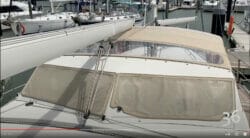
It seems a pity to have a nice safe traveler position like that and then lead the mainsheet in such a way as it can garrotte a crew member. If it were me designing the system I would go with a “German Mainsheet system” with the track where it is and the mainsheet double ended and lead back from blocks below the gooseneck to winches either side of the cockpit.
And yes, raising the mainsheet traveler closer to the boom enables windward sheeting with a shorter track.
Hey John, New to AAC, loving it so far, trying to soak up as much as I can. I am looking to re-rig my 1980 Ingrid 38 ketch, following the simple is best approach you teach here. We are preparing to sail her from San Diego to Japan (where we live) across the south pacific. Do you know any good riggers in the Southern California area? Boat is in San Diego.
Early this year I did a major refit of my Islander 36 with the excellent support of the Ventura Harbor Boatyard. Work completed included a rebuilt mast step, new cap/intermediate shroud chain plates, and new standing rigging. The boatyard recommended a local rigger, Kim Weir, and I was extremely pleased with his work. Without hesitation, I recommend the services of VHBY and Kim Weir.
Thanks for coming up on that.
Sorry, I have never sailed on the west coast, so don’t have any experience with riggers there. That said, Brian Toss’s old shop is still in business run by guys Brian taught, so that might be an option, although a ways from you: http://briontoss.com
Also see Steve’s comment.
No one has mentioned self-tacking jibs. Having owned two boats with them the thought of going back to winching every time you tack -particularly when singlehanded- fills me with horror. Huge genoas are, in any case, only a relic from ancient rating rules. Whether a jib boom ( particularly the internal boom as used on Freedom sloops) or jib traveller is used, short tacking becomes an effortless exercise. A small jib on a traveller can be trimmed more easily and efficiently than a Genoa. The mainsail is always the prime driver; the performance gain from oversized headsails is less than you think, and in these days of easily deployed offwind headsails is not a consideration off the wind.
I agree with most all you say, except I have never been a fan of jib booms, probably something to do with being naturally clumsy so I don’t need anything else to trip over on the foredeck!
Anyway, just loving sailing our J/109 with her big mainsail and blade jib.
On an otherwise good boat would you recommend moving the lines from the cockpit to the mast if you were going to have an e-wincher anyway, which would presumably overcome the extra friction while still giving the operator enough feel to know if something was going wrong?
Way too many variables to answer that: boat, usage, crew, how well the boat is set up with lines aft, and on it goes. That said, my 109 is lines aft and the wincher makes all the difference to practicality so I have no plans to change. That reminds me, I should do a tip on why.
Newest Posts
- Reviews and Ratings: What You Need to Know
- Test Drives and Sea Trials: A Comprehensive Overview
- Identifying Your Needs: Choosing the Right Boat Type
- Personal Watercrafts: A Comprehensive Overview
- Inflatables and tenders
- Ribs and rigid inflatables
- Inflatable sailboats
- Inflatable kayaks and canoes
- The Art of Boat Building: A Guide from an Expert
- The Ins and Outs of Boat Shipping Companies
- Racing sailboats
- Houseboats and yachts
- Motor yachts
- Sailing yachts
- Luxury houseboats
- Personal watercrafts
- Ski and wakeboard boats
- Fishing boats
- Cabin cruisers
- Pontoon boats
- Choosing a boat type
- Identifying your needs
- Power or sail?
- Budget considerations
- Types of propulsion systems
- Selecting a dealer or broker
- Checking references
- Negotiating pricing and financing
- Researching boats
- Comparison shopping
- Reviews and ratings
- Test drives and sea trials
- Design and planning services
- Hull design and engineering
- Cabin design and layout
- Materials and construction services
- Woodworking and joinery services
- Metal fabrication services
- Finishing services
- Painting and varnishing services
- Upholstery and canvas services
- Electrical system repair services
- Wiring and rewiring services
- Electrical system diagnostics and troubleshooting
- Engine repair and maintenance services
- Inboard engine repair and maintenance
- Outboard engine repair and maintenance
- Structural repairs and maintenance services
- Deck repairs and maintenance services
- Hull repairs and maintenance services
- Transport options for boats
- Shipping a boat by ocean freight or air freight
- Towing a boat by trailer or truck
- Use A1 Auto Transport Boat Transport Services And Claim 15% Off
- Logistics for boat transport
- Documentation requirements for boat transport
- Insurance requirements for boat transport
- Boat unloading services
- Unloading boats from air freight containers
- Unloading boats from ocean freight containers
- Replacement parts
- Replacement outboard motors
- Replacement inboard motors
- Replacement electrical components
- Preventive maintenance services
- Cleaning and waxing the hull
- Cleaning and polishing the topsides
- Inspecting the rigging
- Repair services
- Engine repairs
- Electrical system repairs
- Hull repairs
- Assessing the condition of the boat
- Testing the electrical systems
- Identifying damage to the hull
- Inspecting the riggin
- Restoration work
- Rewiring the electrical systems
- Refinishing decks and topsides
- Replacing rotten woodwork
- Finishing touches
- Painting the hull
- Installing new upholstery
- Varnishing woodwork
- Cabin Design and Layout Explained
- Boat building services
Designing and laying out the cabin of a boat is an important process that can determine the comfort, usability, and safety of the vessel. Cabin design and layout involve a variety of factors, from the size and shape of the space to the type of furniture and fittings used. It's essential to understand the principles of cabin design and layout to ensure that your boat is as comfortable, safe, and enjoyable as possible. In this article, we will explore the basics of cabin design and layout, from the fundamentals of space and function to more advanced considerations such as materials and decorations. When it comes to cabin design and layout , there are a number of different styles to consider.
The most common style is the traditional, rectangular-shaped cabin. This style is often seen in smaller fishing boats and can be easily adapted for larger boats. Other popular styles include the domed or rounded cabin, which is more common in larger yachts, as well as the curved or elliptical cabin, which is often seen in luxury yachts. When planning your cabin design and layout , it is important to consider how you will use the space.
If you are looking to maximize space, then it is best to opt for a rectangular cabin layout. This allows for more storage and seating options and provides an easy-to-navigate floor plan. If you are looking for a more luxurious feel or want to create a more unique look, then you may want to consider a domed or curved cabin layout. In addition to style, there are also several different types of layouts that you can choose from. The most common type of layout is the open plan layout, which has no walls or dividers between rooms.
This type of layout is great for creating an open and airy feel in your boat cabin. Another type of layout is the multi-room layout, which divides the space into several separate rooms. This type of layout is often seen in larger boats as it provides more privacy between living areas. Once you have chosen a style and layout for your cabin, it is important to consider the materials you will use for its construction. Different materials will affect the overall look and feel of your cabin as well as its durability and maintenance requirements.
Planning Ahead
To ensure a safe cabin environment, make sure that all areas of the space are easily accessible in case of an emergency. Additionally, check for any sharp edges or objects that could cause injury, and ensure that any windows or doors are securely fastened so they cannot be opened accidentally. When designing your cabin, also consider the types of materials you will need to use. Certain materials, such as wood and fiberglass, may be more durable and provide better insulation, while others may provide a more visually appealing aesthetic. Additionally, make sure to take into account any additional features that you might want to include in your cabin design, such as built-in furniture or ventilation systems. By taking the time to plan ahead and carefully consider all aspects of your cabin design and layout, you can create a space that is both comfortable and safe.
Types of Layouts
Different styles of cabins.
Other popular styles include the domed or rounded cabin, which is more commonly seen in larger yachts, as well as the curved or elliptical cabin, which is often seen in luxury yachts. These styles of cabins provide different levels of comfort and functionality depending on their design. For example, the rectangular cabin provides a straightforward layout that is easy to work with and has plenty of room for amenities. On the other hand, the domed cabin offers a more spacious feel but requires careful consideration when it comes to the placement of furniture and amenities. The curved or elliptical cabin is a great option for those looking for a luxurious feel. This type of cabin is often seen on larger yachts and provides ample space for seating, dining, and entertaining.
Safety Considerations
Construction materials.
Common materials used in cabin construction include wood, fiberglass, and steel. Each material has its own advantages and disadvantages, so it is important to weigh all of your options carefully before making a final decision. Wood is a traditional material used in boat construction, and it offers a warm and natural aesthetic. However, wood can be prone to moisture damage and requires regular maintenance and refinishing to keep it looking its best. Fiberglass is a strong and durable material that is resistant to water damage and requires little maintenance.
Steel is also a strong material that is resistant to water damage, but it can be more expensive than other materials. When selecting construction materials for your cabin design, it is important to consider not only the aesthetic qualities but also the functionality of the materials. It is also important to consider the budget for your project before making any final decisions. Cabin design and layout is a critical component of any boat building project. By taking into account the different styles of cabins, the various types of layouts, the construction materials to be used, and safety considerations when planning ahead, you can create a cabin design that is both comfortable and safe. Choosing the right style and layout for your cabin design will not only provide a comfortable and functional space but can also add to the aesthetic of your boat. With careful consideration and planning, your cabin design and layout can be an integral part of your boat building project.
- Ribs and Rigid Inflatables: What You Need to Know
- Daysailers: An Informative Overview
- Cruisers: An In-Depth Look at One of the Most Popular Sailboat Types
- Catamarans: Exploring the Versatile Boat Type
- Trimarans - Exploring the Unique Three-Hulled Sailboat
- Everything You Need to Know About Bowriders
- Understanding the Differences between Power and Sail Boats
- Motor Yachts: A Comprehensive Look at the Luxury Boating Option
- Boat Selection: Budget Considerations
- Sailing Yachts: An Overview
- Everything You Need to Know About Racing Sailboats
- Discovering the World of Luxury Houseboats
- Everything You Need to Know About Ski and Wakeboard Boats
- Everything You Need to Know About Fishing Boats
- Inflatable Sailboats: Everything You Need to Know
- Inflatable Kayaks and Canoes: Everything You Need to Know
Cabin Cruisers: An In-depth Look at Powerboats
- Pontoon Boats: Everything You Need to Know
- Everything You Need To Know About Catamarans
- Checking References for Boat Selection and Broker Selection
- Comparing Boats: A Comprehensive Overview
- Exploring Hull Design and Engineering
- Wiring and Rewiring Services for Boats
- Inboard Engine Repair and Maintenance
- Types of Propulsion Systems: An Overview
- Diagnosing and Troubleshooting Electrical Systems
- Deck Repairs and Maintenance Services: Everything You Need to Know
- Outboard Engine Repair and Maintenance: Everything You Need to Know
- Woodworking and Joinery Services: An Overview
- Painting and Varnishing Services: A Comprehensive Overview
- Metal Fabrication Services - A Comprehensive Look
- Shipping a Boat - Choosing Between Ocean Freight and Air Freight
- Documentation Requirements for Boat Transport
- Negotiating Pricing and Financing for Boat Selection
Everything You Need to Know About Upholstery and Canvas Services
- Towing a Boat by Trailer or Truck
- Unloading Boats from Air Freight Containers
- Replacement Outboard Motors: Everything You Need to Know
- Cleaning and Waxing the Hull: A Comprehensive Guide
- Testing the Electrical Systems: An Overview
- A Comprehensive Overview of Engine Repairs
- Rewiring Electrical Systems for Boat Restoration
- Cleaning and Polishing the Topsides
- Insurance Requirements for Boat Transport
- Painting the Hull: A Comprehensive Overview of All Aspects
- A Comprehensive Overview of Electrical System Repairs for Boats
- How to Repair Your Boat Hull
- Inspecting the Rigging: A Comprehensive Guide
- Refinishing Decks and Topsides: A Restoration Work Guide
- Replacement Inboard Motors: What You Need to Know
How to Replace Rotten Woodwork
- Unloading Boats From Ocean Freight Containers
- Identifying Damage to the Hull - A Comprehensive Guide
- Inspecting the Rigging: Assessing the Condition of the Boat
- Hull Repairs and Maintenance Services: Everything You Need to Know
- Replacement Electrical Components: A Comprehensive Overview
- Installing New Upholstery: A Step-by-Step Guide
- Varnishing Woodwork: A Comprehensive Guide
New Articles

Which cookies do you want to accept?

- About Modern Wooden Boats
- Tips & tricks
- What’s inside a boat plan ?

Petrel 33: widen your horizons
Petrel 33 is the logical evolution of her smaller sister petrel 28 , with the task to expand the horizons of cruising activity for a 4-6 person crew, raising the bar of onboard comfort, keeping the boat size under the critical (for a homebuilder) size of 34 foot – 10 meters of overall length., a “new classic” looking cruiser, sturdy, with no frills and weird solutions, ready to let you sail with a decent speed and a very good comfort level both at anchor and sailing., the starting point is the very good sailing capabilities shown by the petrel 28, so i decided to develope this hull into a enlarged design, keeping a quite narrow hull for actual standard, prolonging the bow lines for a plumb stempost; i expect to have a similar behaviour of the proven 28footer, with a tender weather helm in every situation, a very soft and gentle wave riding attitude in a seaway, and a good acceleration coming out of the tacks, i expect a little bit more speed given the longer water length ; section are moderately full at the bow, maximum beam is around 60% of hull lenght , transom sections keep a moderate vee.

Stability calculations give us good parameters (see stability curve attached) , with a real large positive area stability, a 123° AVS (Angle of Vanishing Stability) with loaded boat, and a minimal negative area in the stability curves.

Rig and sailplan:
Sailplan is based on a 50% area split among mainsail and a furling jib ; we kept the upwind sailing area to a moderate value, avoiding “wannabe racers” temptations; a decent sized gennaker can be hoisted on the fixed bowsprit, an obvious choice given the fact that the new generation furlers are making this sails very easy to manage for cruising crews too, adding the pleasure of sailing downwind in light airs at a decent pace, a weather situation which is quite a pain in normal mainsail + jib configurations ; in roughest situation you can hoist a storm jib on a removable internal stay fitted on a high load chainplate leaning on the forward structural bulkhead ; rig is a classical 2 spreaders mast , spreaders are 15° swept, there is a structural backstay and no structural runners, lower shrouds are doubled., deck gear configuration features classical sturdy and manageable solutions, without too many frills : 4 self tailing winches to pull sheets, halyards and control lines, 2 stoppers array on cabin top panel, 2 tracks for jib cars, so that the jib can keep a decent shape even furled, a small track for the mainsail purchase, all the control lines are led to cockpit to avoid bow walks in “spicy” situations (plans will detail how to make bombproof fitting points for lifelines too);, boat will be powered by a diesel (20-30 hp) or electric (7 kw) inboard engine fitted with a saildrive or shaft-line transmission ; this will allow to keep a decent pace while motoring in zero wind situation, or to add a good booster to sail thrust if needed; i expect to reach a 6.5 knots boat speed at 2000 rpm with a 30 hp diesel engine., rudder and steering system:, rudder is a single blade semi-compensated one with tiller steering system ; there will be two options detailed on plans: spade rudder with ss steel shaft (this solution is depicted in rendered images), and an easier to build transom hung rudder., finkeel is naca profile keel made of welded steel plates, ; ballast is made by lead poured in the keel hollows ; keel is fitted on the hull with a web of bolts on solid hardwood floors, with nuts and high thickness ss steel counterplates under the cabin floorings; keel load is carefully distributed to avoid any local high stress area., interiors and on board living:, this area marks the main differences among this 34 footer and her smaller sister; higher hull topsides and two more meters of boat make a world of difference in terms of interiors and on board comfort; we have 6 regular berths, a comfortable galley and dinette area, a decent volume for on board systems and storage, all that you need to medium-long range sailing given the size of the boat ; both forward and after cabin are closed with a small door to gain a little bit more privacy ; cabin height is around 191 cm , cockpit is quite wide, and it’s designed to be comfortable for a crew of 6 while sailing with the heeled boat too ; transom area is protected by a sturdy wooden hinged structure that can be lowered when moored to be used as a transom platform. low sleek coamings protect the forward area of the cockpit , making the primary winch basement too; toerails and good sized areas among cabin flanks and hull sheerline make going to the bow a very safe operation even when boat is heeled and in rough conditions;, building system:, given the good amount of miles sailed by petrel 28 in every sea state with very good reliability, i keep a similar structure for this project, upgrading the scantlings to cope with higher stresses; so the boat structure is a grid of plywood bulkheads and frames linked by solid wood stringers and a mixed plywood-solid wood structure forming keel backbone and stempost ; hull planking is made by 12 mm plywood, with the radiused area made by two layers of 6 mm plywood panels , all glued to the underlying structural grid , in a reliable , sturdy and easy to build system called “radius chine” ; cabin , cockpit and deck surfaces are made by 10-12 mm plywood panels stiffened by a grid of secondary stringers, solid beams and other structural elements; the hull bottom is further stiffened by a number of solid wood floors , tightly spaced in the centerboat area, where they bear the finkeel loads. all critical areas and structural bondings are strengthened and stiffened by epoxy resin laminated glass fabric and epoxy resin liquid joinery and structural bondings. this building system is definitely suited to be realized by home builders or small boatyards, with a basic level of wood craftmanship , in a decent amount of time given the size of the boat., in my view this will allow a small boatyard to build and offer a highly customized top level sailboat keeping the final prize to a reasonable level, which is basically the main concern when it comes to manage a small boatyard..

Building plans and study plans: project Petrel 33 is is completed : now I’m starting the long and meticulous process of drawing the building plans; complete plans will be available approximately at the end of spring at this link , anyway if someone is so committed to long for an immediate start of construction he can purchase plans starting from now, a first batch of drawings (hull parts , assembly scaffold and hull structures) will be delivered within a week so that he can start building, the rest will follow as scheduled within half of June 2018; study plans and bill of materials will be available approximately within the end of April 2018 and will be downloadable form this page for free, as usual. Stay tuned !!!
Plans price: 900 € for paper sheets, 840€ for pdf format drawings, 350 € for cad engraving files (required if you want to cut all the plywood parts with cnc machinery, includes keel steel plating shapes) ; plans will be made approximately of 27 drawings and a 25 pages booklet with assembly sequence, tips and tricks, plans can be purchased here, a discount will be available for the first buyer ., petrel 33 specifications, hull length: 9,90 m (bowsprit included), overall length: 9,90 m, maximum beam: 3,03 m, prismatic coefficient: 0,53, sink rate: 170kg/cm, canoe body wet surface: 18 m2, draft at design displacement: 1,80 m, vacant ship diplacement: 3400 kg (all gear up, no water and food, no fuel), design displacement: 4050kg (crew of 4 + luggage, 50kg fuel, acqua 150 liters water, 100 kg extra), maximum displacement: 4500 kg (crew of 6 + luggage, full fuel, full water), ballast: 1300 kg: fixed keel, upwind sail area : 47,3 m2 , mainsail 23.2 m2, jib 24 m2, staysail on removable babystay: 6.5 m2, gennaker: 65 m2, mast height on dwl: m 13,3, performance parameters : sa/displ^0.66 = 19.5 , sa/wet surface = 2.6 (canoe body only), engine: diesel inboard with saildrive or shaftline transmission, 20-30 hp, 50 liters fuel tank , electric engine specifications on plans, accommodations: 6 fulls sized (1,90 m or more) berths, 1 v berth at bow, 1 double berth on transom , 2 galley berths, interiors: charting table with main electric panel, vhf radio and chart plotter area, galley with stove, sink and 30 liters fridge, enclosed toilet with wc sink and shower, central table in dinette with foldable wings. 190 cm height in the whole galley area., systems: 12 v and 220 v wiring scheme, fresh water and black water plumbing scheme, 200 or more liter freshwater tanks.; two service batteries and a engine dedicated battery, ce label : possible b6/c10 , data to be required as extra item..
- plans: 900€ for paper version, 840 for PDF version , 350 for CNC cutting files , can be purchased here
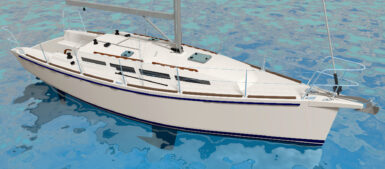
Dory Cabin Plans
- Create New Wish List
- Description
five cabin plans for our Little Hunk, Hunky Dory, Big Hunk, Chunky Dory and V-Dory
Put a cabin on your GLEN-L dory. Convert HUNKY DORY, LITTLE HUNK, BIG HUNK, CHUNKY DORY or V-DORY to a deluxe cruiser with a choice of five different cabin styles. Details on all versions are furnished in DORY CABIN PLANS; with dimensional layouts for cabin exterior, interior joinery, control console, plus structural details, lumber sizes, fastening schedule, and instructions. Only minor modifications are required, so add a cabin while building, or retrofit one after hull completion. A floor plan is given in the DORY CABIN PLANS along with suggested cabinetry. All trunk versions feature large vee berths forward with sitting headroom. Versions B, C, and E have space for port and starboard cabinets or head and cabinet. Pilothouse versions have 6' plus headroom, helm station, cabinets and space for stove and sink. Although specifically for Glen-L dories, it is probable, with minor variations, that these CABIN PLANS could be used to build a cabin on similar craft.
VERSION A: Small trunk cabin forward, ideal for LITTLE HUNK; also practical for HUNKY DORY, BIG HUNK, CHUNKY DORY or V-DORY. VERSION B: Pilothouse with trunk cabin forward adaptable to HUNKY DORY, BIG HUNK, CHUNKY DORY or V-DORY*. Can be built with pilothouse walk-a-round decks or full sheer-level conventional decks. VERSION C: Trunk cabin with flying bridge for HUNKY DORY, BIG HUNK, CHUNKY DORY or V-DORY. VERSION D: Trunk cabin with flying bridge and optional hardtop. Use on HUNKY DORY, BIG HUNK, CHUNKY DORY or V-DORY. Can be used on LITTLE HUNK without hardtop. VERSION E: Pilothouse with walk-a-round decks adaptable to HUNKY DORY, BIG HUNK, CHUNKY DORY or V-DORY.* *Not suitable for V-DORY when using in-line motor.

Related Products
Chunky dory.

Little Hunk

Better Sailing

Best Sailboats With 2 Cabins
The passion of living and voyaging overseas is difficult to explain to people that can’t live without their basic needs and additional comforts. But if you choose the right sailboat tailored to your needs and preferences you might be able to live on a sailboat and have more comforts than expected. Choosing a well-designed, robust, spacious, and seaworthy sailboat is the key to successful passagemaking. So, are you looking to accomplish your dream and sail overseas with a 2-cabin sailboat? Then, continue reading this article. I’m going to list the best 2-cabin sailboats to live on and travel overseas as well as their characteristics. Follow me!
Island Packet 35
The full-keel IP 35 with a high-freeboard hull design still proves her value and is one of the best choices amongst sailors. The beamy IP 35 has a robust construction, spacious interiors and great amenities that make her a great cruising sailboat. The IP 35 was firstly introduced in 1988 and has a comfy and roomy interior as well as a large cockpit, and an easy-to-handle cutter rig with a jib boom. Even though she’s not the fastest boat upwind, she can perform well in trade winds. All these features make the IP 35 a good option for family cruising. Lastly, she can cruise on long-passages and as for her price, you can find a well-maintained used model with approximately $75,000.

>>Also Read: Best Sailboats Under 100k
Catalina 30
The Catalina 30 deck forms a very functional boarding space. Even though they first appeared on the market in 1972 they still continue to sail in the seas. Furthermore, these reliable fiberglass models are the most common ones in terms of production. The galley of Catalina 30 has large counter space and two private double cabins, one forward (V-berth) and one aft. The forward cabin is a V-berth formation. Also, the sofa converts and forms two more berths on the starboard side. It is possible to find a good and properly maintained Catalina 30 with the price of $15,000.

>>Also Read: Best Sailboats Under 30 Feet
The old-time classic Pearson 34 will give you the appropriate space you need in order to sail for a long time offshore. She has spacious accommodations and is easy to handle making her ideal for enjoying the joys of cruising. Her aft sections are full which increases sail carrying power and her forward sections are moderately full so as to provide buoyancy. A classic arrangement plan is used for the below decks resulting in the best use of space.
Oceanis 311
The Oceanis 311 is a practical and roomy high-performance cruiser and racer. She can accommodate 6 persons and has 2 cabins placed below her deck. The accommodation layouts have a double-berth cabin on the port side aft and a double V-berth in the forepeak. The galley and WC are situated on the port side, the small navigation area is situated on the starboard, and the table on the centreline. As for the headroom, it’s around 6 ft. The boat doesn’t have a convertible saloon but has a convertible settee which forms two single berths. Lastly, the 311 combines appropriate internal volume and a fast hull, making it ideal for long offshore passages.
Beneteau First 31.7
This sailboat has achieved the right balance between sailing performance and accommodation. This family of Beneteau’s First sailboats designed by the Finot Group is highly appreciated among sailors for their resistance and high-performance. The First 31.7 features a high freeboard, a self-bailing cockpit, and a wide transom. Her design is simple and efficient, provides enough room for provisions which makes it great for long passages. Moreover, the 31.7 model is the more compact design of the Beneteau First 40.7 model. Its large beam provides plenty of interior volume with a simple layout of 2 cabins and one head. The main cabin is in the V-berth forward and has approximately 6ft of standing headroom. The galley is situated to the port side and includes a sink, a stove, and a refrigerator. Aft of the boat is the second private cabin with standing headroom and a double berth.
Hallberg-Rassy 310
The Hallberg-Rassy 310 is a fast and easy-going boat with her simple design and her robust GRP construction which makes her great for ocean cruising. She is a 30ft monohull sloop and features a deck steeped mast configuration. Furthermore, it has a spacious and comfy interior including 2 cabins, enough space for storage, and an L sofa with a straight settee. You can find a properly maintained used Hallberg-Rassy 310 with approximately $160,000. She’s definitely included on our top list of 2-cabin cruisers/racers!

>>Also Read: Best Sailboats to Live On
Moorings Beneteau 38.2
This exceptionally designed monohull is proven to be seaworthy, stable, and reliable for overseas sailing. Her hull design ensures excellent performance even under strong winds due to her wide beam towards the stern construction. Furthermore, she has a large cockpit area that facilitates walking, relaxing, and dining on the deck. Her interior is equipped with two cabins and two bathrooms and has space to accommodate from 6 to 8 persons. The galley has all basic amenities such as a refrigerator, an oven as well as extra seating and countertop space. She is one of the sailboats that provide more than enough amenities for a long offshore sailing and she definitely worths the investment!
Peterson 44
The Peterson 44 is one of the best center-cockpit cruisers that can sail well in any wind, and she’s ideal for overnight cruising or day sailing. The sailboat has a split-cabin both fore and aft and a generally roomy and comfy interior without putting aside its excellent sailing capabilities. Through the passageway, to starboard and back, is the aft cabin, with a double berth and separate head with shower. The traditional main cabin is situated forward and includes a dinette to port and settee to starboard. Moreover, there’s a second head with a shower and a large V-berth. All these amenities and space combined with this seaworthy and easy-to-handle sailboat can’t let me without putting her on our list. On today’s market, you can find her from $100,00 to $125,000.
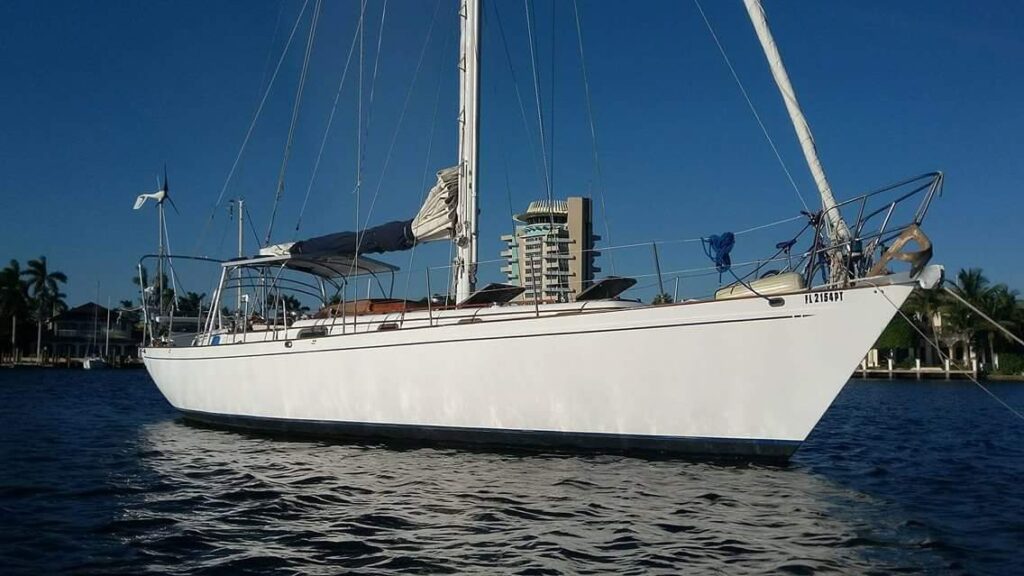
The ideal high-sided family cruiser that ensures easy handling, speed, and comfort. With a large cockpit area, a practical walk-through transom, and with spacious interior/outdoor areas, you can enjoy your days sailing overseas. Moreover, she has dual-ended mainsail sheeting and the headsail sheet winches are adequately placed to the helm. The sheets are well built into the companionway bulkheads so as to facilitate the control of halyards and furling lines led aft to the cabin top. The galley and saloon areas are large enough to cook and relax and both cabins are bright and spacious. Lastly, she’s quick and quite responsive while sailing and adequate for coastal cruising with your whole family!
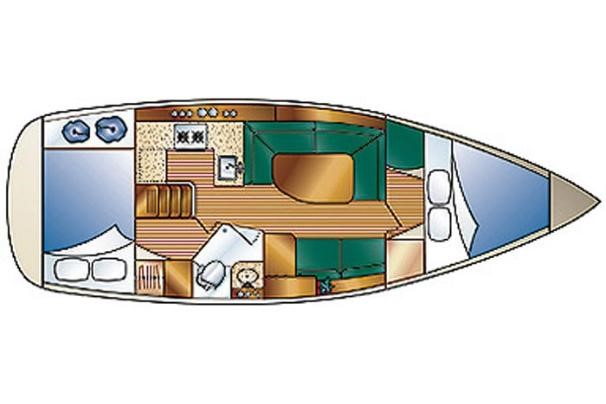
>>Also Read: Best Small Sailboats To Sail Around The World
Bavaria C42
This modern and innovative Bavaria C42 won’t let you down in terms of sailing performance and offshore sailing. Her V-shaped bow hull shape with chines, the large amount of space, and robust construction are the characteristics that make this model one of the best 2-cabin boats on our list. Better performance is achieved due to the chines that ensure stability and direct feeling while steering. Also, the foredeck and side decks have enough space for a sailboat of this size and the hull design creates extra space below the deck. So, there’s everything in the Bavaria C42; 2 luxurious cabins with a bathroom, a roomy saloon with a lounge bench, extra headroom in the bow cabin, and generous storage capacity. You’ll definitely appreciate her design and sailing performance and she’ll certainly prove her worth!
These are some great 2-cabin sailboats adequate for either offshore sailing or just for coastal cruises with your friends and family. Again, everything depends on your needs, preferences, and budget when you’re planning to buy a new or used yacht. So, you need to consider everything before buying a 2-cabin sailboat. Your crew members, your routes, your budget, comfort needs, amenities and sailing performance. There’s a wide variety of different options out there to choose from and you’ll definitely find what you’re looking for. Bon voyage!
Peter is the editor of Better Sailing. He has sailed for countless hours and has maintained his own boats and sailboats for years. After years of trial and error, he decided to start this website to share the knowledge.
Related Posts

The Ultimate Guide to Choosing the Best Fishing Line for Trolling

Lagoon Catamaran Review: Are Lagoon Catamarans Good?

Best Inboard Boat Engine Brands

Are O’Day Sailboats Good? A Closer Look at a Classic Brand
- Buyer's Guide
- Destinations
- Maintenance
- Sailing Info
Hit enter to search or ESC to close.
- New Sailboats
- Sailboats 21-30ft
- Sailboats 31-35ft
- Sailboats 36-40ft
- Sailboats Over 40ft
- Sailboats Under 21feet
- used_sailboats
- Apps and Computer Programs
- Communications
- Fishfinders
- Handheld Electronics
- Plotters MFDS Rradar
- Wind, Speed & Depth Instruments
- Anchoring Mooring
- Running Rigging
- Sails Canvas
- Standing Rigging
- Diesel Engines
- Off Grid Energy
- Cleaning Waxing
- DIY Projects
- Repair, Tools & Materials
- Spare Parts
- Tools & Gadgets
- Cabin Comfort
- Ventilation
- Footwear Apparel
- Foul Weather Gear
- Mailport & PS Advisor
- Inside Practical Sailor Blog
- Activate My Web Access
- Reset Password
- Customer Service

- Free Newsletter

Mason 33 Used Boat Review

Beneteau 311, Catalina 310 and Hunter 326 Used Boat Comparison

Maine Cat 41 Used Boat Review

Cheoy Lee Clipper 36 & 42 Used Boat Review

Tips From A First “Sail” on the ICW

Tillerpilot Tips and Safety Cautions

Best Crimpers and Strippers for Fixing Marine Electrical Connectors

Thinking Through a Solar Power Installation

Stopping Mainsheet Twist

Working with High-Tech Ropes

Getting a Clue for the Blown-Out Clew

Monel Seizing Wire is Worth the Extra Cost

Fuel Lift Pump: Easy DIY Diesel Fuel System Diagnostic and Repair

Ensuring Safe Shorepower

Sinking? Check Your Stuffing Box

The Rain Catcher’s Guide


Boat Maintenance for the Technically Illiterate: Part 1

Whats the Best Way to Restore Clear Plastic Windows?

Mastering Precision Drilling: How to Use Drill Guides

Giving Bugs the Big Goodbye

Galley Gadgets for the Cruising Sailor

Those Extras you Don’t Need But Love to Have

UV Clothing: Is It Worth the Hype?

Preparing Yourself for Solo Sailing

How to Select Crew for a Passage or Delivery

Preparing A Boat to Sail Solo

On Watch: This 60-Year-Old Hinckley Pilot 35 is Also a Working…

On Watch: America’s Cup

On Watch: All Eyes on Europe Sail Racing

Dear Readers

Chafe Protection for Dock Lines
- Sailboat Reviews
- Sails, Rigging & Deck Gear
A Practical Look at Sailboat Cockpit Design
Ps outlines what to look for when searching for a comfortable, functional cockpit..

Cockpit ergonomics involve more than a concern about coaming angles and comfortable seating. These are just two items on a long list of attributes that define the space where sailors spend most of their waking time.
At boat shows, the crowd can be divided into those that poke around on deck and those who head directly below. Brokers know the difference between racing sailors and cruisers and which end of the companionway ladder will seal the deal. Racers want performance and scrutinize the on-deck design features that make it all happen, while cruisers look below for the amenities of a house afloat. This stereotype may be too rigid, but from what we’ve seen at recent boat shows, cruisers need to take a closer look at the cockpit and get a feel for how a sailboat will handle underway, as well as serve as a home away from home.
There’s much more at stake than comfort for the crew. Cockpit design and layout drives many boat-handling tasks, ranging from steering and sail trimming to what goes on when its time to reef. Angles of view can even affect watchkeeping.
For example, a high center cockpit and a large overlapping genoa create a 90-degree-plus no see zone, and thats a big deal when it comes to collision avoidance. A large catamaran with a tall bridge-deck cabin can add an even larger no see zone, especially when running on autopilot with no one perched on the elevated helm seat.
In short, many cockpits are optimized for at-anchor enjoyment instead of underway usability. So part of the boat-shopping process should include careful scrutiny of how essential sailing and boat-handling tasks will be accomplished. For starters, note how much contortion it takes to really crank each winch, determine whether or not the line leads favor easy reefing, and check to see how well the cockpit shape contributes to keeping the crew from being washed overboard. These are essential attributes, and for some, they are more vital than galley counter material and the fabric that covers the cushions below.
Grand Prix racers have long favored wide open, low sided, no-transom cockpits that are more of an open deck than a protective trench. In heavy weather, these nothing-to-cling-to cockpits can become perilous. In 1997, during the Hong Kong to Osaka, Japan Race, Americas Cup trials veteran Makoto Namba was at the helm of Escape One when a 20-foot breaking sea washed him out the open transom of the 45-foot racer. In 2006, Dutch Volvo Ocean racer Hans Horrevoets was swept from the deck of ABN AMRO TWO and lost at sea. Closer to home, pro sailor Dan Cianci was tossed over the lifelines of the 50-foot ocean racer Snow Lion. The accident occurred at night, in heavy weather just off the Delaware River mouth. In each case, the cockpit design favored sail trim and line handling over heavy-weather safety considerations. Many ocean racers mitigate such design tradeoffs with careful use of harnesses, tethers, jack lines, and hard points for tether attachment.
Just the opposite design trend can be found in the deep cockpit and conventional closed transom of sailboats such as Ted Hoods 25-year-old design, American Promise. Dodge Morgan sailed the heavy-displacement 60-footer solo around the world. The big, double-head rigged sloop provided a great deal of crew protection and seakeeping ability during Morgans voyage. And for years after he donated the boat to the U.S. Naval Academy, midshipmen also learned to appreciate the cockpit layout-particularly during bad weather offshore.
PS Technical Editor Ralph Naranjo sailed that boat in a gale-strewn trans-Atlantic with an able crew and encountered a nasty 979-millibar low at about 45 degrees North latitude. According to the log, AP was reaching eastward at 9 knots under storm trysail and storm jib with green water routinely sweeping the deck. Seas had silenced the mini-M satphone by regularly immersing the dome shaped antenna in wave faces, eventually flooding the internal circuitry.
It was a rough passage, and little things taken for granted in smoother seas showed their true value. Features like the deep cockpit well, the heavy-duty, water-tight companionway doors, and the massive cockpit drains all proved their worth.
The flip side of the coin is that really bad weather encounters are a rare occurrence for most sailors. More often, 0- to 20-knot sailing conditions prevail. And our coastline is dotted with safe havens in which to hide from the elements. So one of the big challenges facing every designer and naval architect drawing lines for their next new boat is the question of exposure. Will owners use the boat as a dockside second home and be underway only in fair weather, or will they take the cruiser label to heart and leave land well astern? A close look at cockpit layouts will give you some indication of the boats intended use.
We prefer to evaluate cockpit ergonomics from both static and dynamic points of view. On some boats, these underway and at anchor evaluations lead to disparate conclusions. A cockpit that works well underway may be confining in port, or another vessel with a patio-size stern may be altogether dysfunctional at sea. It’s all an issue of trying to do two different jobs with one fixed set of dimensions and appendages. Buyers need to know what attributes they will make best use of.
For monohulls, coping with heel is the first big challenge, and wide-open space, whether its in the cockpit or main saloon, can be a tough challenge. The universal solution to carrying wide beam aft on cruising boats seems to be the ubiquitous cockpit table. It can be a handy centerline support, but it’s a tough addition to a seafaring cockpit in the minds of many traditional sailors. That said, production boatbuilders have gotten much better at making these centerline, folding-leaf tables sturdy enough for sea duty and effective as a handhold.
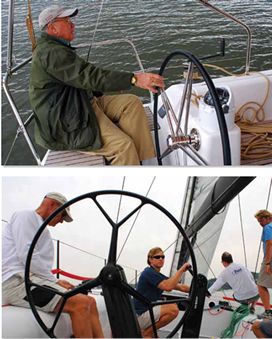
Industry Trends
Over the last 50 years, mainstream production sailboat design has moved noticeably away from the racer/cruiser defined by Pearson, Tartan, C&C, Cal, Columbia, Ranger, Islander, Ericson, and others. The new boats are roomier with less emphasis on performance under sail. Racers now have their own genre of sailboat, and they are faster, better handling, and more capable than their predecessors. But whats most surprising is that many mainstream cruisers are anything but optimized for long-distance passages and long-term living aboard.
These boats feature convenience, style, and comfort, and the actual design objective in many cases is more focused on weekend cruising and an annual two-week summer harbor-hopping cruise. Easy sail-setting and large boat interiors in shorter waterline lengths prevail, and such trends influence the shape and layout of the cockpit. When it comes to ergonomics, the split between cruisers and racers is more apparent than ever, but theres also some real differentiation within the ranks of cruisers themselves.
In Practical Sailors recent scrutiny of cockpit designs at local boat shows, weve noted four emerging sailboat stereotypes. These include daysailers that feature few, if any, accommodations; racing boats brimming with performance-enhancing hardware; and ocean-going cruisers capable of extended passagemaking. The fourth grouping-larger than all the other three combined-are also labeled cruisers, but with less draft, less stability, and less versatile sail plans, they are more like an SUV designed more for the highway than off-roading in the backcountry.
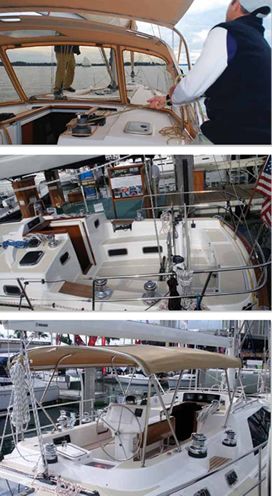
Sizing Up a Cockpit
The takeaway lesson for us was the importance of making sure that the cockpit of the boat you are about to buy is in keeping with the mission of the rest of the boat. If you are a serious club racer, the centerline table wont be a crew favorite. Those making a double-handed passage on a 40-footer will see a tight, narrow cockpit differently than when eight sail the same boat. So with complete belief in the old adage, different strokes for different folks, heres what we looked for when evaluating cockpit design. It can be used as a helpful buyers guide when you’re surveying your next boat.
Working the winches: All too often, winch location is an afterthought, and fine hardware is stuck on side coamings shaped more as a roof for the aft cabin than as a key component of sail trim. We always like to check sheet leads angles that lead lines to a particular winch and then mimic what cranking with a two-handed winch handle would be like. Look for 360-degree clearance with no knuckle-busting stanchions in the way. Be sure that the winch grinding works on either tack. Genoa sheeting may always put you on the leeward side of the cockpit, but runners and spinnaker guys will usually be worked on a windward winch.
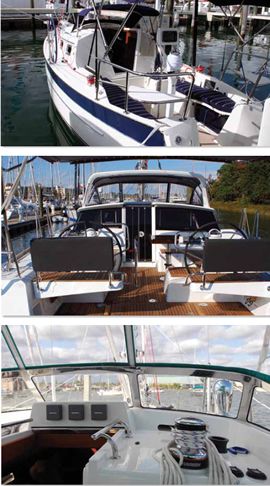
Sheets and halyards: One of testers major complaints was builders habit of running seldom-used halyard lines attached to roller-furling headsails and in-mast furling mainsails all the way aft to the cockpit. Doing so left lengthy line tails cluttering up the area under the dodger where reefing lines, the boom vang, and in some cases, the main sheet all arrived like too many trains in a station.
Theres no perfect mainsheet arrangement, but some are better than others, and the one you choose has a lot to do with how much attention you pay to the nuance of sail trim. The current vogue among serious racers involves 2-to-1 end-boom sheeting: an in-boom lead of the double-ended sheet returns aft via turning blocks near the mast and runs to winches on both sides of the boat (often referred to as Admirals Cup, or German mainsheet). Fast, no-load hand trimming is the upside, but in any breeze, theres good reason to quickly get the sheet on a winch drum. The sheet tail is shorter because of the low ratio (2-to-1) lead. One nuisance is that the sheet can end up bunched up on one side or the other.
Many cruisers prefer higher ratio, multi-part tackles for mainsheeting and may lead each end to a Harken-type adjustment system rather than using a winch. When fast tacking action is not in the cards, this is a user-friendly system.
Some cruisers incorporate mid-boom sheeting because it moves the tackle out of the cockpit than rather then because of how effectively it allows the mainsail to be trimmed. The shortened lever arm means the sheet needs a winch sooner than later. There is also more of a leech-flattening, vang-like effect to this type of sheeting, not the best feature for light-air efficiency.
The trend toward travelers roosting on over-cockpit arches, a longtime standard in Hunter Yachts and a recent adoption in some Beneteau lines, helps protect the crew from accidental jibe injuries and allows dodgers and biminis to flourish, but windows in these covers are essential, if a crew is to see whats happening whey they are pulling the strings.
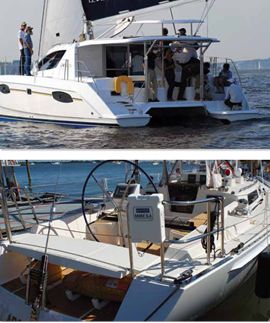
Anticipate the angles: Look at how things will change as heel increases and note where vulnerability lies. We recently ran into a crew who had lost an engine due to the shape of the cockpit. During the design phase, the location for an engine instrument recess was placed within easy reach of the person at the helm. In an upright trim-and even at 30 degrees of heel-all was well, but in a knock down when the cockpit began to flood, the engine instruments ended up in a low spot, and despite their sealed all-weather design, submerging them in saltwater had not been part of the engine manufacturers gameplan. The ensuing corrosion took out the panel and the alarm system, and a novice crew failed to notice the changes in sound and smell as a raw-water blockage in the cooling system went critical.
Those headed offshore need to pay special heed to the companionway and have a feel for what angle of heel sends water down an open hatch. Whats a surprise to many is that the first part of the hatch to reach the water may be the top rather than the lower portion of the companionway. Sticking in a washboard or two will help keep a breaking wave from sloshing below, but it may be of little use in a deep knockdown.
Getting in and out: One of the most important safety features of a good boat is the transitional path that leads a crew from the cockpit to the deck. Good engineering focuses on step heights, deck camber, handholds, and the quality of the nonskid surface. This transition in and out of the cockpit is one of the most repeated movements on the vessel. If a dodger, bimini, or Florida room compromises access, they become a hazard. Small, molded steps are of little help in a seaway.
There is no ideal cockpit that meets everyones preferences, and plenty of bad ideas still persist. No matter what your aims are as a sailor, some things deserve to take precedence. Ample space for entertaining friends for sundowners dockside is nice, but comfort underway, including ergonomic seats for sitting or napping, and secure places to steer and stand watch when the boat is heeled should be a higher priority.
Likewise, sight lines and sensible sheet arrangements should come before drink-holders. Next time you prowl the boat show, spend some time exploring the cockpit and comparing features. It is the hub of the boat.
Rating cockpit attributes is a worthwhile endeavor for a serious boat shopper. Start by rating component parts. It will allow you to more effectively compare and contrast one boat with another, according to your specific sailing plans and needs.
For example: Above, we have focused on seven key cockpit attributes and rated five new boats accordingly. Below is a brief explanation of each of the criteria selected. The result of the data table is not a winner-take-all report card. It’s a means of determining what has been emphasized in a specific cockpit design on a wide variety of very different vessels.
Rating for this attribute reflects both the location of a winch and the way in which crew members must bend, lean, or contort themselves while sheeting. We considered how efficiently a manual winch could be cranked and whether or not an electric winch could be safely operated while retaining a clear view of the sail being sheeted or hoisted.
This was not a look at the vessel’s steering hardware, rudder design, or feel of the tiller. It was more focused on helm location and how the person steering the boat could carry on the process comfortably for lengthy periods of time.
We consider the ability to quickly and efficiently reduce and add sail area to be a primary aspect of seamanship. Cockpit layouts teamed up with efficient well-chosen hardware can make or break this facet of cockpit ergonomics. Awkward winch placement, too many lines clustered together around a big bank of rope clutches, and attempting to place sheets, halyards, and reefing lines all in the helmsman’s lap with only one or two undersized winches usually lead to lower ratings.
Collision avoidance requires seeing what’s about to cause trouble well ahead of time, and anything shy of a 360-degree angle of view detracts from the process. We were concerned about view angles and obstructions ranging from dodgers, to deck-sweeping headsails, cabinhouse bulkheads, and other design features that limit the helmsperson’s field of vision. Aboard many multihulls, there’s a growing trend toward providing one perch that offers an all-around view. But when the vessel is operating on autopilot and no one is in the elevated helm seat, watchkeeping efforts are hampered.
When floating on an even keel, it’s easy to get in and out of most cockpits. However, a modest heel of 15 degrees can turn wide-open cockpits with awkward coamings and narrow sidedecks into a hazard. Getting around on a vessel in a seaway requires good nonskid, an abundance of ready handholds, and an unobstructed pathway in and out of the cockpit. Seats need to be usable underway, and the dodger, companionway, and bimini must work in concert.
Short Handing
Because most cruisers sail short-handed, we are always on the look out for features that make watchkeeping more user friendly. These include line leads and winch layouts that allow headsail trimming from the helm and may even offer the chance to tuck or shake a reef from the confine of the cockpit. Crew alone on deck also benefit from deeper-welled open space. Giving the short-handed crew protection from seeping seas and offering well-placed hardware goes a long way to ensure safe, efficient passagemaking.
Entertaining
At anchor and in port, the cockpit changes from an operations center to a backyard patio. Gone is the need for seakeeping attributes, and what counts is how well the area at the aft or center portion of the boat stacks up as a place for stationary fun. Tables that can serve dinner for six or drinks for 10 get high marks. Transoms that fold down, offering access to the sea, are also a current rage. It’s no surprise however, that many of the attributes that drive high scores for entertaining earn a lower grade at sea—the reason many designers and builders have spent time developing fold-up swim platforms and wellreinforced drop-leaf tables ready for sea duty.
VALUE GUIDE: Comparing Cockpit Design
| VESSEL | TRIMMING | STEERING | REEFING | VISIBILITY | HEELED | SHORT HANDLING | ENTERTAINING |
|---|---|---|---|---|---|---|---|
| FARR 400 | Excellent | Excellent | Fair | Excellent | Excellent | Poor | Fair |
| BENETEAU SENSE 43 | Fair | Good | Good | Good | Fair | Fair | Excellent |
| DUFOUR 445 | Fair | Good | Fair | Good | Good | Good | Good |
| LEOPARD 39 | Fair | Good | Fair | Fair | NA | Fair | Excellent |
| PASSPORT 545 CC | Fair | Good | Good | Excellent | Good | Good | Excellent |
RELATED ARTICLES MORE FROM AUTHOR
Leave a reply cancel reply.
Log in to leave a comment
Latest Videos

The Perfect Family Sailboat! Hunter 27-2 – Boat Review

Pettit EZ-Poxy – How to Paint a Boat

The Boat From True Spirit – Sparkman & Stephens

Top 5 Boat Hacks – Boat Maintenance Tips and Tricks
Latest sailboat review.

- Privacy Policy
- Do Not Sell My Personal Information
- Online Account Activation
- Privacy Manager

Cabin Interior Design
We can help you renovate your cruiser, sail boat or houseboat interior fabrics, vinyls, upholstery, draperies, carpet, wall covering, canvas, decor, and much more!
- Cruiser Interiors – Make your cruiser interior as unique as your taste, this is where you get to let your creativity take over and develop an environment that represents you! We can help you choose carpets, fabrics, and leather like materials to fit your exquisite style. We can also fabricate custom bedding, window treatments, accent pillows; even help you find the most fabulous accessories to complete your boat interior decor.
[widgetkit id=1363]
- Houseboat Interiors – Your houseboat offers purpose, comfort and luxury on the lake. Keep it updated with the latest upholstery and interior designs. With minor changes you can achieve the elegant boating experience you’ve been dreaming of. See our Houseboat Renovations Page
[widgetkit id=1365]

- Interior Fabrics – Sunbrella interior fabrics help keep your boat’s interior in-style and looking beautiful. Interior fabrics are fit to meet your every interior design need including upholstery, window treatments, awnings and accessories. Sunbrella interior fabrics come in a wider variety of textures, colors and patterns to bring beauty and durability into your interior space.

- SERVICES OVERVIEW
- CARPET/FLOORING
- CANVAS, COVERS, BIMINI TOPS
- MARINE UPHOLSTERY
- CABIN INTERIOR DESIGN
- HOUSEBOAT RENOVATIONS
- CUSTOM EMBROIDERY
- CUSTOM CANVAS & ENCLOSURES
- PRINCESS PADS OR SUNPADS
- CUSTOM OTTOMANS
- OTHER SERVICES
- TESTIMONIALS
- ONLINE STORE
- JOIN OUR TEAM
- Testimonials
Cibele and her staff take great pride and passion in their work. Brian Canty
SCHEDULE A FREE CONSULTATION TODAY
- 678.714.7122
- [email protected]
- Quote Request
- Photo Gallery

10 Best Sailboats To Live In

Last Updated by
Daniel Wade
December 28, 2023
Living aboard a sailboat is an exciting lifestyle choice, but there are lots of considerations you’ll need to make.
First and foremost, you have to pick a boat to live in. Unless you plan on sleeping under a canvas tarp, it’s essential to find a sailboat with a proper cabin.
Cabin sailboats became common in the United States during the early 20th century, but size and amenities vary widely between boats.
For example, early wooden sailboats generally featured very sparse accommodations below, typically consisting of a pipe berth, oil lamps, a coal-fired stove and a bucket privy—typically without standing headroom.
Fortunately, the majority of cabin sailboats came with a lot more than a bucket to wash with.
In this article, we’ll go over some of the most important considerations to make when choosing a sailboat to live on . After, we’ll give a top-ten list of the best used liveaboard sailboats you can buy today.
Table of contents
Why Live Aboard a Sailboat?
Thousands of people choose to live aboard their sailboats. It’s an alternative lifestyle with a host of benefits for those willing to deal with the added challenges.
Liveaboards can move their entire house on the water, and it’s typically cheaper to live on a boat than in a traditional house.
This is especially true in major waterfront cities, where rent in the same area as the marina can be several times more expensive.
Some people love the marina lifestyle, and others travel the world. All-in-all, living aboard a sailboat can be a rewarding, enriching, and financially-freeing lifestyle choice.
What to Consider when Buying a Liveaboard Sailboat
The most important thing to consider when buying a liveaboard sailboat is what level of accommodation you need.
Some people aren’t bothered by limited amenities; in fact, many traditional sailors prefer a stripped-down and basic sailboat interior. However, many others appreciate useful features such as electric toilets and a full galley.
You can find virtually every creature comfort on board a modern sailboat, so it’s up to you to decide what level of convenience you expect.
For most people, a standard cruising sailboat interior from after 1970 will suffice, as these typically include a usable galley, shower, head, and ventilation.
Offshore VS Coastal Cruising Accommodations
Sailboat interior design is dependent on certain criteria, such as the sailboat’s intended use. Long-distance cruising sailboats have cabins arranged to suit such a journey.
Long-distance sailboats usually remove any unnecessary furniture or extras down below to increase storage, and sleeping options are altered to ensure easy access, which allows the crew to regain control of the boat in a pinch.
Coastal cruisers tend to feature a more luxurious layout, with larger sofas and more complex interior features. Additionally, storage space is generally reduced to allow for the inclusion of other amenities.
Whichever style you choose should reflect both how you plan to use your boat and what level of comfort you need.
What Makes A Great Liveaboard Sailboat?
For this article, we’ve outlined a few requirements which we believe identify an excellent liveaboard sailboat :
- Standing headroom (at least 5’10”)
While many people live aboard boats without standing headroom, it’s still a nice feature to have. Months or years spent crawling or crouching can wreak havoc on your back and body, so standing headroom is a necessity in this list.
- 120V AC availability
Electricity is a definite requirement for our liveaboard list. Boats without 120V AC outlets present major challenges to liveaboards, as there’s no way to charge most computers or cell phones. Some boats feature a 12V outlet, but full-time liveaboard boats should have standard house connections for electricity.
- Galley facilities
Unless you plan on eating out every day, a galley is a must for our list. We define an adequate galley as a facility with a sink, ice box or refrigerator, and a stove. An oven is an added bonus, but one can usually be added along with a new stove.
- Electric lighting
Electric lighting is a matter of both safety and convenience aboard boats. There’s nothing wrong with kerosene lamps; many sailors adorn their boats with them. However, a long-term liveaboard boat should feature safe and reliable electric lighting.
- Toilet with plumbing
Sanitation facilities are vital on board a sailboat, especially if you live on it. Improper human waste storage and disposal will spread awful diseases. Plus, nobody wants to live on a stinky boat or use a porta-potty all year long. We required each of our ten boats to have built-in and properly outfitted toilets, plus safe storage tanks for pumping out later.
Bathing facilities are also a must on most liveaboard sailboats. However, many liveaboards opt not to use their on-board showers in favor of marina or gym facilities. That being said, it is very convenient to have a shower on your boat. Keep in mind, some boat showers drain directly into the bilge. If you use your onboard shower, be sure to keep the bilge pump in working order and remember that anything you put in the drain ends up below your floor.
- Separate seating spaces
We think a liveaboard sailboat should have extra sitting spaces on board, apart from the main bed. A place for sitting, eating, working, and navigating is essential when living aboard long-term, and the added convenience of a separate space will make day-to-day activities much more enjoyable.
- Ventilation
Last but not least, we believe ventilation is essential for any liveaboard sailboat. This is the simplest of requirements, as a passive solar roof vent or opening porthole should be sufficient. In short, there should be a way to let fresh air in without opening a main hatch.
Top 10 Liveaboard Sailboats
Here’s a list of the top ten liveaboard sailboats that you can purchase used today.
These are in no particular order, but each boat meets or exceeds the requirements of a great liveaboard sailboat.
Remember, the features listed for each of these boats could vary based on age or trim, so be sure to check back to this list when inspecting a boat.
Without further ado, here’s ten of the greatest liveaboard sailboats ever produced.
1. Catalina 30
{{boat-info="/boats/catalina-30"}}
The Catalina 30 is one of the most common production cruising sailboats ever.
Thousands of these reliable and robust fiberglass boats still sail, despite the fact that they first entered the market in 1972.
This 30-foot boat features a modern and spacious interior, with all the accommodations you’d expect on a boat its size.
Most models feature a large and useful galley, along with running water supplied by electric pumps.
The Catalina 30 also featured a ‘suite’ layout, with a master bedroom V-Berth closed off to the rest of the cabin by a door.
An enclosed shower and head make it a pleasant boat to live on.
The layout of the Catalina 30 also featured a dinette, which serves as an excellent chart table or workspace as well.
2. Islander 36
{{boat-info="/boats/islander-36"}}
The Islander 36 is a well-rounded liveaboard sailboat which also has impressive cruising capabilities.
While manufacturing ceased in the 1980s, the I-36 was the company’s best-selling model with nearly a thousand built.
Islander boats are known for some well-adorned cabins, and many featured elegant wooden interior trim.
Like the Catalina 30, the Islander 36 includes an enclosed head with a shower and flush toilet.
The interior layout of the I-36 is spacious and well-designed, featuring a long port and starboard settee which folds out into a double-berth for sleeping.
An enclosed shower and spacious master berth make it a very well-rounded option for cruising and living aboard.
3. Contessa 32
{{boat-info="/boats/contessa-32"}}
Contessa Yachts produced their venerable 32-foot cruising and racing sailboat from 1970 until 1990, but custom boatbuilders still manufacture the yacht today.
It’s well-known for cruising capabilities, but it has a lot to offer as a liveaboard as well.
The traditional cabin is thoughtfully designed, featuring a fold-up table in the center of the cabin floor.
The spatially conscious design of the Contessa 32 makes it an excellent option for the no-frills and organized sailor.
This vessel features a separate master bedroom, along with a head and shower in the hallway between the compartments.
4. Pearson 34
{{boat-info="/boats/pearson-34"}}
Pearson produced their excellent 34-foot sailboat during the 1980s. This medium-sized cruising yacht features an extremely spacious interior with plenty of floor space to move around.
The layout is complex, but not overwhelming. The galley nook is functional and features convenient overhead storage for utensils giving it a ‘home-y’ feeling.
The head is enclosed and spacious, including a bathroom sink and mirror.
The separate master bedroom is also enclosed with ample clothing storage throughout.
Out of all the boats listed so far, the Pearson 34 should feel most like a traditional living space to most people.
If the Pearson 34 seems a little too compact, be sure to read on and check out the next two boats on the list.
5. Nordic 40
{{boat-info="/boats/nordic-40"}}
So far the largest boat on our list, the Nordic 40 is a super-capable offshore cruiser with excellent liveaboard facilities.
This relatively rare boat features an extremely spacious interior, which is more than ample for a couple to live comfortably.
Standing headroom throughout, a spacious master bedroom, along with a nearly full galley allows for superbly comfortable living in any climate or region.
The extra storage aboard makes remote living possible, so owners can anchor out for weeks or months at a time with enough provisions to last.
While this boat isn’t very common, it’s still worth keeping an eye out for it while searching for a liveaboard sailboat .
6. Peterson 44
{{boat-info="/boats/kelly-peterson-44"}}
The Peterson 44 is what’s known as a ‘center-cockpit cruiser,’ featuring a split-cabin both fore and aft.
This spacious interior layout maximizes living space without decreasing sailing capabilities.
The boat features a master bedroom and bathroom, along with another cabin, berth, and head behind the cockpit.
In addition to two bathrooms, it features a full galley, booth dinette, and settee.
All these extras combined with excellent storage make it an excellent liveaboard option.
Pearson is well-renowned for building excellent boats, and their interior quality is above average.
7. Nor’Sea 27
{{boat-info="/boats/norsea-27"}}
The Nor’Sea 27 is a classic compact sailboat, which is ideal for minimalist or single people living aboard.
The interior is surprisingly spacious for its size, featuring all the amenities you’d expect on a larger boat.
This beautiful little boat likely mimics the comfort of a Catalina 30, and should cost less in slip fees.
The interior features a toilet, shower, and galley.
The forward berth converts into a dinette but features two other bunks underneath the cockpit.
Production of the Nor’Sea 27 began in 1976, and it’s still produced today.
And the best part—you can legally tow it on a trailer. It’s arguably the ultimate compact cruiser/liveaboard available today.
{{boat-info="/boats/cal-34"}}
The Cal 34 is very typical of mid-range sailboats of the 1970s. Produced between 1968 and 1975, this basic but comfortable yacht has a lot of potential as a liveaboard.
The interior is simple and spacious, without much luxury or adorning. However, less features make for less maintnence, and everything you’d need is available in the Cal 34.
A master bedroom, shower, and toilet are all standard, along with a well-arranged galley and comfortable sitting area.
The boat features ample storage for clothes, food, and gear.
All mechanical, electrical, and plumbing systems aboard are easy to maintain, plus the cabin is well-designed.
9. Catalina 38
{{boat-info="/boats/catalina-38"}}
Another classic Catalina sailboat makes the list, with a well-thought-out interior that’s spacious enough for a couple to live comfortably.
Catalina produced their 38-foot sloop between 1977 and 1990, and it came standard with many excellent liveaboard features such as electrical outlets throughout the cabin.
Also, the head is spacious and includes a sink, which is always very convenient.
With plenty of places to sleep, there’s no need to fold away the galley table to get some rest.
The Catalina 38 is another fantastic mid-sized sailboat for living aboard, especially if you aren’t quite comfortable inside a Catalina 30.
10. Hunter 33
{{boat-info="/boats/hunter-33"}}
The last boat on our list is also one of the longest-lived in its category. Hunter produced their 33-foot sailboat starting in 1977, and it’s still in production today.
This handy mid-sized boat features excellent interior accommodations, with plenty of sitting and sleeping areas to choose from.
In addition to a full dinette, it features a toilet and shower aft away from the master bedroom. Such an arrangement is a great option for sailors, as it allows the use of the head without moving too far away from the controls.
Standing headroom throughout the long cabin makes for a very comfortable long-term living arrangement.
The galley has plenty of storage space and the L-shaped layout allows for easy and efficient use.
At the end of the day, you’ll get to choose the liveaboard sailboat that works best for you. Check out some of the boats we mentioned and get an idea of what they offer.
Use this list to help identify features that you need, and perhaps avoid features that you don’t want.
When it comes to living aboard, there’s a lot more to consider than just your boat. As long as the boat you choose is in good condition, you’ll likely end up falling in love with it.
Either way, consider these top-ten liveaboard sailboats when you’re on the hunt for your boat.
Related Articles
Best Liveaboard Catamaran Sailboats
5 Best Liveaboard Bluewater Sailboats
Living On A Sailboat - Pros & Cons
How To Live on a Sailboat
I've personally had thousands of questions about sailing and sailboats over the years. As I learn and experience sailing, and the community, I share the answers that work and make sense to me, here on Life of Sailing.
by this author
Best Sailboats
Most Recent

What Does "Sailing By The Lee" Mean?
October 3, 2023

The Best Sailing Schools And Programs: Reviews & Ratings
September 26, 2023
Important Legal Info
Lifeofsailing.com is a participant in the Amazon Services LLC Associates Program, an affiliate advertising program designed to provide a means for sites to earn advertising fees by advertising and linking to Amazon. This site also participates in other affiliate programs and is compensated for referring traffic and business to these companies.
Similar Posts

Affordable Sailboats You Can Build at Home
September 13, 2023

Best Small Sailboats With Standing Headroom

Best Bluewater Sailboats Under $50K
Popular posts.

Can a Novice Sail Around the World?
Elizabeth O'Malley
June 15, 2022

4 Best Electric Outboard Motors

How Long Did It Take The Vikings To Sail To England?

10 Best Sailboat Brands (And Why)
December 20, 2023

7 Best Places To Liveaboard A Sailboat
Get the best sailing content.
Top Rated Posts
Lifeofsailing.com is a participant in the Amazon Services LLC Associates Program, an affiliate advertising program designed to provide a means for sites to earn advertising fees by advertising and linking to Amazon. This site also participates in other affiliate programs and is compensated for referring traffic and business to these companies. (866) 342-SAIL
© 2024 Life of Sailing Email: [email protected] Address: 11816 Inwood Rd #3024 Dallas, TX 75244 Disclaimer Privacy Policy
- CruiseMapper
MSC World Europa deck plans
Deck layouts, review of facilities, activities, amenities.
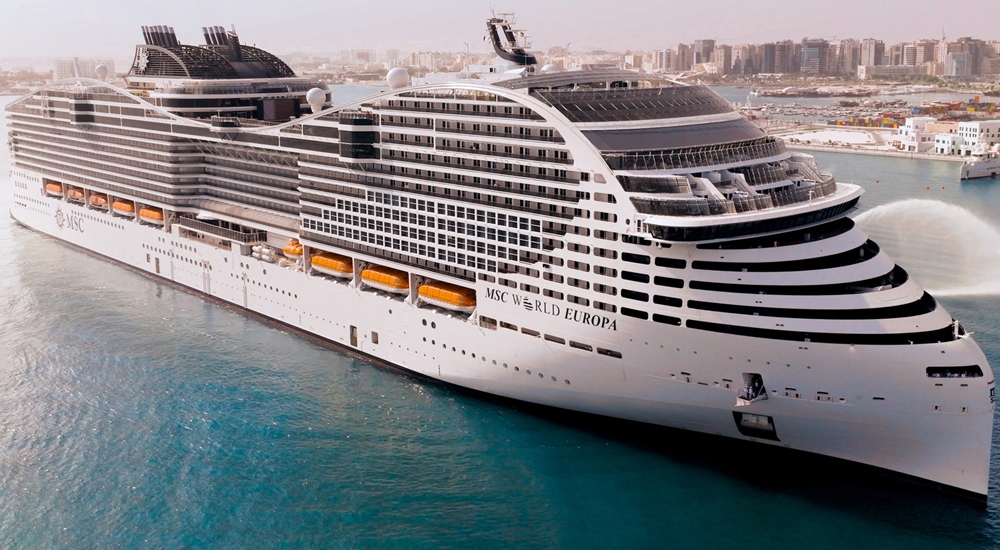
MSC World Europa deck plan review at CruiseMapper provides newest cruise deck plans (2024-2025-2026 valid floor layouts of the vessel) extracted from the officially issued by MSC Cruises deckplan pdf (printable version).
Each of the MSC World Europa cruise ship deck plans are conveniently combined with a legend (showing cabin codes) and detailed review of all the deck's venues and passenger-accessible indoor and outdoor areas. A separate link provides an extensive information on MSC World Europa staterooms (cabins and suites), including photos, cabin plans and amenities by room type and category.
MSC World Europa (2022-built) is the first WORLD-class vessel of MSC Cruises - the fleet's largest and most innovative ships ever constructed. With the same design are three more liners (sisterships) with deliveries in 2025 ( MSC World America ), 2026 ( MSC World Asia ), and 2027 (tbn).
MSC World Europa cruise ship deck plan shows 2633 staterooms for 5240 passengers (max capacity is 6782) served by 2138 crew-staff. The boat has 20 decks (16 passenger-accessible, 12 with cabins), 13 dining venues/restaurants and food bars (including 3x MDRs-dining rooms, 6x specialty restaurants), 21 lounges and bars, 7 swimming pools, 13 Jacuzzis (outdoor whirlpools/hot tubs, including 4x cantilevered), 39 elevators (11 of which are Panoramic / glass-walled-floored Lifts in the Atrium).
MSC World Europa decks are named after European capital cities - Berlin (Germany), Rome (Italy), London (UK), Madrid (Spain), Dublin (Ireland), Vienna (Austria), Moscow (Russia), Copenhagen (Denmark), Prague (Czechia), Brussels (Belgium), Bern (Switzerland), Athens (Greece), Paris (France), Lisbon (Portugal), Valletta (Malta).
This unique ship has 40,000+ m2 (430,000+ ft2) of public space, 15000 m2 (161,000 ft2) outdoor deck space, 3440 m2 (37000 ft2) main pool deck area, 760+ m2 (8200 ft2) of children's interior complex designed by Lego & Chicco (with 7x rooms dedicated to different age groups), Zen District (adults-only wellness and relaxation complex), Family District (with 10 kids facilities/pools, clubs, playgrounds), Family Sundeck (kids-friendly sunbathing area), Aquapark (with outdoor playgrounds, splash pools, water cannons, 3x waterslides with virtual reality experiences), Teens Sundeck (with a swimming pool and spa pool).
Deck layouts
Deck 05 - berlin-cabins, deck 06 - rome-lobby-lounge, deck 07 - london-casino-shops, deck 08 - madrid-promenade-spa, deck 09 - dublin-cabins, deck 10 - vienna-cabins, deck 11 - moscow-cabins, deck 12 - copenhagen-cabins, deck 14 - prague-cabins, deck 15 - brussels-cabins-bridge, deck 16 - bern-cabins-duplex suites1, deck 18 - athens-cabins-lido-pools-duplex suites2, deck 19 - paris-cabins-kids-top sail lounge, deck 20 - lisbon-cabins-gym-waterpark, deck 21 - valletta-cabins, deck 22 - amsterdam-waterslides-the spiral-yacht club sundeck.
MSC World Europa deck plans are property of MSC Cruises . All deck layouts are for informational purposes only and CruiseMapper is not responsible for their accuracy.

- Plans & Kits

- Qty in Cart

West Mersea Duck Punt PDF Free Plans

Making Hand Screw Clamps Free Instructions

Tape & Glue Process Free Instructions
Lisa b good - free plans.

Folding Mast & Boom Free Plans PDF

Slipper PDF

Drifter 12L Free Plans
Wanigan (free plans).

1 Sheet Wedge Plans PDF

Drifter 12 Free Plans

Mouse Free Plans
Little bretton free plans.
- Total: items /
- Add all to cart
Adding your products to cart
.png)
- DREDGE/CIVILS
- AUSMARINE (OCEANIA)
- MIDDLE EAST/NORTH AFRICA
- LATIN AMERICA
VESSEL REVIEW | Sinichka – Electric commuter boats designed for Russia’s Moskva River

A series of three new electric monohull commuter ferries have already begun operational sailings on the Moskva River in the Russian capital Moscow.
Built by Russian shipyard Emperium, sister vessels Sinichka , Filka , and Presnya – all named after rivers in Moscow – are being operated by the Moscow Department of Transport and Road Infrastructure Development (Moscow Deptrans). They are the first units of a planned fleet of 20 vessels that will serve the capital city and other nearby communities. The new ferry system will be the water transport system to be operated on the Moskva River in 16 years.
Each vessel has a welded aluminium hull, an LOA of 21 metres, a beam of 6.2 metres, a draught of only 1.4 metres, a displacement of 40 tonnes, and capacity for 80 passengers plus two crewmembers. Seating is available for 42 passengers on each ferry, and the main cabins are also fitted with USB charging ports, wifi connectivity, tables, toilets, and space for bicycles and scooters. The cabin layout can be rearranged to allow the operator to adjust the distances between the seats and to install armrests of varying widths.

An open upper deck is also accessible to passengers and is the only area on each ferry where smoking is allowed.
The ferries are all of modular construction with each ferry's wheelhouse, main cabin, and other structural elements being built as complete, separate components. This enables the ferries to be easily dismantled for transport to anywhere in Russia by rail and then quickly re-assembled within seven days.
The ferries are also ice-capable. Recently completed operational trials on the Moskva showed that the vessels can also easily navigate under mild winter conditions with broken surface ice, though year-round operations are planned for the entire fleet.
The ferries are each fitted with 500kWh lithium iron phosphate battery packs that supply power to two 134kW motors. This configuration can deliver a maximum speed of 11.8 knots, a cruising speed of just under 10 knots, and a range of 150 kilometres.
Emperium said the transfer of rotation of electric motors to the propeller is carried out by direct drive. As a propulsion installation, a pulling rotary propeller-steering column with double screws is used. The installation of double pulling screws, with similar power, allows an operator to increase the efficiency of the propulsion system to deliver a slightly higher speed or to reduce energy consumption. This arrangement also provides the ferries with enhanced manoeuvrability necessary for navigating in close quarters.
The batteries themselves have projected service lives of 10 to 12 years and are fitted with safety features such as built-in fire extinguishers and gas vents. Quick-disconnect features allow the batteries to be easily removed for replacement or maintenance.
Some of our readers have expressed disquiet at our publication of reviews and articles describing new vessels from Russia. We at Baird Maritime can understand and sympathise with those views. However, despite the behaviour of the country's leaders, we believe that the maritime world needs to learn of the latest developments in vessel design and construction there.
Click here to read other news stories, features, opinion articles, and vessel reviews as part of this month's Passenger Vessel Week.
| Type of vessel: | Commuter ferries |
| Flag: | Russia |
| Operator: | Moscow Department of Transport and Road Infrastructure Development, Russia |
| Builder: | Emperium, Russia |
| Hull construction material: | Aluminium |
| Length overall: | 21 metres |
| Beam: | 6.2 metres |
| Draught: | 1.4 metres |
| Propulsion: | 2 x 134 kW |
| Maximum speed: | 11.8 knots |
| Cruising speed: | 10 knots |
| Range: | 150 kilometres |
| Batteries: | Lithium iron phosphate, 500 kWh |
| Accommodation: | Cabin; toilets; bicycle/scooter area |
| Crew: | 2 |
| Passengers: | 80 |
| Operational area: | Moskva River, Russia |
Related Stories

Motor yachts
Charter Companies

C15917 - Dufour 520 GL (2019) - Milazzo, Italy
- 1 Instant Sailing Yacht Charter
- 1 Sailing destinations
- 1 Sicily region
Yacht basic info
Additional equipment list.
Inventory list
Available extras
Yacht layout.

Instant Sailing expert Tonka
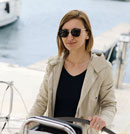
Similar yachts for charter

Oceanis 50 Family (2012) - 5 cab
Rosignano solvay italy.

Dufour 520 GL (2019) - 5 cab
Palermo italy.

Oceanis 46.1 (5 cab) (2021) - 5 cab

Sun Odyssey 519 (2019) - 5 cab
Capo d'orlando italy.

Oceanis 46.1 (2021) - 5 cab
Scarlino italy.

Oceanis 48 (2017) - 5 cab
Carloforte italy.

Oceanis 46.1 (5 cab) (2020) - 5 cab
Salerno italy.

Oceanis 54 (2010) - 5 cab
Cagliari italy.

Sun Odyssey 519 (2016) - 5 cab

Oceanis 51.1 - 5 + 1 cab. (2021) - 5 cab

Jeanneau 53 - 5 + 1 cab. (2011) - 5 cab
Olbia italy, price calculator, obligatory - not included in price:, charter period (saturday-saturday):, price calculation:, payment plan:, we are sorry but this yacht is not available or is under option in selected period, dear clients since our calendar is in real time, if you see all periods in red this means that this boat is not yet in booking for next season. please be kind and send us inquiry for custom offer., select date for real time prices, need more info - or help with planning, what happens when i click on "book now".
Once you click on Book Now button and fill out all information required, we will then confirm your request and automatically put chosen boat under option for 3 days, which means nobody else can book it in that period. In those 3 days, in order to confirm your booking you will have to make your first payment as stated in payment plan.
Which boat licence do I need?
To sail a boat in most countries you’ll need an internationally recognized boat licence, such as RYA, ICC, Radio License or CEVNI. However, this rule may vary from one country to another, therefore before departing on your trip we advice you to contact our team to see what kind of licences are accepted.
What is a security deposit?
Security deposit is refundable and you will receive it after check-out (after the boat has been inspected for any damages). However, if you cause damage you are responsible to the amount of security deposit ( it can't be exceeded ) and if your damage is less, the rest will be returned to you. Deposit price depends on the price of the boat.
What is a transit log?
Transit Log is one payment for following services (in most cases) : final cleaning, bed linen, base marina fees, diver check. Transit Log services may differ depending on charter company - you can always contact our support team which will be able to outline the specifics of Transit Log for your booking.
TIPS and FAQ
What is a security deposit for, what is a transit log, when do i hire a skipper, similar yachts available for charter.

- Seen 64912 times
Oceanis 50 Family (2012)
Rosignano Solvay, Italy

- Seen 80873 times
Dufour 520 GL (2019)
Palermo, Italy

- Seen 65093 times
Oceanis 46.1 (5 cab) (2021)

- Seen 65257 times
Sun Odyssey 519 (2019)
Capo d'Orlando, Italy
Secure Checkout
- 1. Payment options 1.
- 3. Contact info 3.
- 5. Review your order 5.
Instant Sailing d.o.o.
Ninska 30, Split, Croatia
VAT: HR51723516898
Yacht details
Charter period
02.08.2017 - 09.08.2017
Till: 09.08.2017
Original price:
Our discount:
(-25%) - 386,00 €
Total price:
Amount to pay now:
IMPORTANT: all extras will be paid in base upon arrival
Bavaria Cruiser 41
Split, Croatia
Client name:
Mr. Marko Markić
Phone number:
00385 95 8168 254
[email protected]

Download pdf offer
- 1. Contact info 1.
- 2. Review offer details 2.
Send us an inquiry
Thank you for doing business with instant sailing, working hours:.
Monday - Friday: 08:00-19:00 (CET)
Saturday: 08:00-16:00 (CET)
Instant Sailing Privacy Policy

Contact info: Call : +385 95 802 8681 Email: [email protected]
Instant Sailing d.o.o. VAT: HR51723516898 Address: Ninska 30, Split, Croatia Offical website: www.instantsailing.com
Instant Sailing Privacy policy
This privacy policy has been compiled to better serve those who are concerned with how their 'Personally Identifiable Information' (PII) is being used online. PII, as described in US privacy law and information security, is information that can be used on its own or with other information to identify, contact, or locate a single person, or to identify an individual in context. Please read our privacy policy carefully to get a clear understanding of how we collect, use, protect or otherwise handle your Personally Identifiable Information in accordance with our website.
What personal information do we collect from the people that visit our blog, website or app?
When ordering or registering on our site, as appropriate, you may be asked to enter your name, email address, mailing address, phone number, credit card information or other details to help you with your experience.
When do we collect information?
We collect information from you when you place an order, fill out a form or enter information on our site.
How do we use your information?
We may use the information we collect from you when you register, make a purchase, sign up for our newsletter, respond to a survey or marketing communication, surf the website, or use certain other site features in the following ways:
- To improve our website in order to better serve you.
- To allow us to better service you in responding to your customer service requests.
- To quickly process your transactions.
How do we protect your information?
We do not use vulnerability scanning and/or scanning to PCI standards. An external PCI compliant payment gateway handles all CC transactions. We use regular Malware Scanning.
Your personal information is contained behind secured networks and is only accessible by a limited number of persons who have special access rights to such systems, and are required to keep the information confidential. In addition, all sensitive/credit information you supply is encrypted via Secure Socket Layer (SSL) technology.
We implement a variety of security measures when a user places an order enters, submits, or accesses their information to maintain the safety of your personal information.
All transactions are processed through a gateway provider and are not stored or processed on our servers.
Do we use 'cookies'?
Yes. Cookies are small files that a site or its service provider transfers to your computer's hard drive through your Web browser (if you allow) that enables the site's or service provider's systems to recognize your browser and capture and remember certain information. For instance, we use cookies to help us remember and process the items in your shopping cart. They are also used to help us understand your preferences based on previous or current site activity, which enables us to provide you with improved services. We also use cookies to help us compile aggregate data about site traffic and site interaction so that we can offer better site experiences and tools in the future.
We use cookies to:
- Help remember and process the items in the shopping cart.
You can choose to have your computer warn you each time a cookie is being sent, or you can choose to turn off all cookies. You do this through your browser settings. Since browser is a little different, look at your browser's Help Menu to learn the correct way to modify your cookies.
If users disable cookies in their browser:
If you turn cookies off, Some of the features that make your site experience more efficient may not function properly.Some of the features that make your site experience more efficient and may not function properly.
Third-party disclosure
We do not sell, trade, or otherwise transfer to outside parties your Personally Identifiable Information.
Third-party links
Occasionally, at our discretion, we may include or offer third-party products or services on our website. These third-party sites have separate and independent privacy policies. We therefore have no responsibility or liability for the content and activities of these linked sites. Nonetheless, we seek to protect the integrity of our site and welcome any feedback about these sites.
Google's advertising requirements can be summed up by Google's Advertising Principles. They are put in place to provide a positive experience for users. Google Adwords Policy
We use Google AdSense Advertising on our website.
Google, as a third-party vendor, uses cookies to serve ads on our site. Google's use of the DART cookie enables it to serve ads to our users based on previous visits to our site and other sites on the Internet. Users may opt-out of the use of the DART cookie by visiting the Google Ad and Content Network privacy policy.
We have implemented the following:
- Remarketing with Google AdSense
- Demographics and Interests Reporting
We, along with third-party vendors such as Google use first-party cookies (such as the Google Analytics cookies) and third-party cookies (such as the DoubleClick cookie) or other third-party identifiers together to compile data regarding user interactions with ad impressions and other ad service functions as they relate to our website.
Opting out:
Users can set preferences for how Google advertises to you using the Google Ad Settings page. Alternatively, you can opt out by visiting the Network Advertising Initiative Opt Out page or by using the Google Analytics Opt Out Browser add on.
California Online Privacy Protection Act
CalOPPA is the first state law in the nation to require commercial websites and online services to post a privacy policy. The law's reach stretches well beyond California to require any person or company in the United States (and conceivably the world) that operates websites collecting Personally Identifiable Information from California consumers to post a conspicuous privacy policy on its website stating exactly the information being collected and those individuals or companies with whom it is being shared. - See more at: consumercal.org
According to CalOPPA, we agree to the following:
Users can visit our site anonymously. Once this privacy policy is created, we will add a link to it on our home page or as a minimum, on the first significant page after entering our website. Our Privacy Policy link includes the word 'Privacy' and can easily be found on the page specified above.
You will be notified of any Privacy Policy changes:
- On our Privacy Policy Page
Can change your personal information:
- By emailing us
- By calling us
- By logging in to your account
- By chatting with us or by sending us a support ticket
How does our site handle Do Not Track signals?
We honor Do Not Track signals and Do Not Track, plant cookies, or use advertising when a Do Not Track (DNT) browser mechanism is in place.
Does our site allow third-party behavioral tracking?
It's also important to note that we do not allow third-party behavioral tracking
COPPA (Children Online Privacy Protection Act)
When it comes to the collection of personal information from children under the age of 13 years old, the Children's Online Privacy Protection Act (COPPA) puts parents in control. The Federal Trade Commission, United States' consumer protection agency, enforces the COPPA Rule, which spells out what operators of websites and online services must do to protect children's privacy and safety online.
We do not specifically market to children under the age of 13 years old.
Fair Information Practices
The Fair Information Practices Principles form the backbone of privacy law in the United States and the concepts they include have played a significant role in the development of data protection laws around the globe. Understanding the Fair Information Practice Principles and how they should be implemented is critical to comply with the various privacy laws that protect personal information.
In order to be in line with Fair Information Practices we will take the following responsive action, should a data breach occur:
- Within 7 business days
We will notify the users via in-site notification
We also agree to the Individual Redress Principle which requires that individuals have the right to legally pursue enforceable rights against data collectors and processors who fail to adhere to the law. This principle requires not only that individuals have enforceable rights against data users, but also that individuals have recourse to courts or government agencies to investigate and/or prosecute non-compliance by data processors.
CAN SPAM Act
The CAN-SPAM Act is a law that sets the rules for commercial email, establishes requirements for commercial messages, gives recipients the right to have emails stopped from being sent to them, and spells out tough penalties for violations.
We collect your email address in order to:
- Send information, respond to inquiries, and/or other requests or questions
- Process orders and to send information and updates pertaining to orders.
- Send you additional information related to your product and/or service
To be in accordance with CANSPAM, we agree to the following:
- Not use false or misleading subjects or email addresses.
- Identify the message as an advertisement in some reasonable way.
- Include the physical address of our business or site headquarters.
- Monitor third-party email marketing services for compliance, if one is used.
- Honor opt-out/unsubscribe requests quickly.
- Allow users to unsubscribe by using the link at the bottom of each email.
If at any time you would like to unsubscribe from receiving future emails, you can email us at
- Follow the instructions at the bottom of each email and we will promptly remove you from ALL correspondence.
Contacting Us
If there are any questions regarding this privacy policy, you may contact us using the information below.
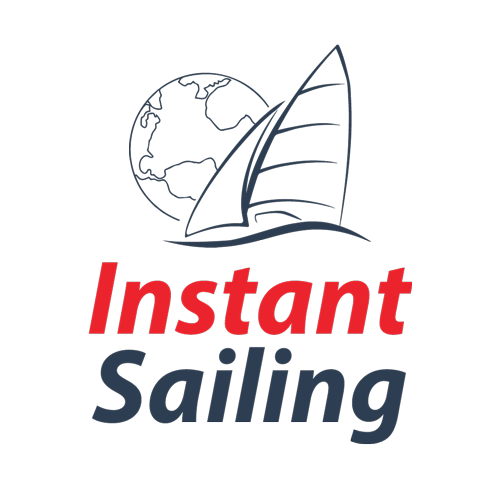
David Hadaller
- Born: 01.01.1999
- Living in: Zagreb, Croatia
- Languages: EN, DE, HR, ES
- Email: [email protected]
- Mobile: +385 98 654 3217
- Jobs: Skipper, hostess
English language:
+44 203 807 3932
+1 866 889 6996
+385 91 5424 630
German language:
+43 7209 02390
Italian language:
+385 21 469 031
French language:
Czech language:, croatian language:, russian language:.

IMAGES
COMMENTS
The best beginner sailboats with cabins are Catalina 22, West Wight Potter 19, Com-Pac 23, Hunter 240, MacGregor 26, Montgomery 17, O'Day 22, Precision 18, San Juan 21, Sea Pearl 21, Sirius 22, Tanzer 22, and Ventura 23. Their prices can range from around $5,000 to $30,000. Whether you're just dipping your toes into the world of sailing or ...
Clever layouts for small sailboat cabins 08-25-2005, 08:15 PM. Hi all, I've been reading around on this site for many weeks now, but since this is my first post, a quick introduction: I'm an English professor at the University of Iowa, and a seasoned sea kayaker who recently took up sailing after building a 14' Pocket Cruiser with my fiancee ...
Cabin cruiser plans and blueprints are essential tools for anyone looking to build their own cabin cruiser. These plans provide a detailed guide on how to construct a cabin cruiser from scratch, including the design, layout, and specifications. Before embarking on such a project, it is crucial to have a well-thought-out plan in place.
Cabin Sailboats to 15' Sort By: Featured Items Newest Items Best Selling A to Z Z to A By Review Price: Ascending Price: Descending Products Per Page: 8 12 16 20 40 100
Construct the cabin frame and install walls, ceiling, windows, doors, and ventilation. Insulate the cabin for comfort and finish the interior with furnishings. Weatherproof the cabin exterior to protect against the elements. Test and refine the boat cabin to ensure it meets your needs and expectations.
Cabin Cruiser, Free Sailboat Plans Petrel You can build this 16ft boat as a day sailer or an overnighter with cabin. Petrel is a Free Sailboat Plan that fulfils the greatest possible variety of uses in one model, offering the builder either an open-cockpit racing craft with comfortable accommodation for day sailing or a snug cabin model with ...
For example, the 21ft gaff-rigged cutter I'm currently building will end up costing between $33,000 and $35,000, fully outfitted—several thousand dollars more than the new prices of a couple of popular fiberglass boats near the same size. And yes, since it's wood, it will demand more maintenance.
Sailboat Deck Layouts. John Harries. Aug 28, 2020. 49 Comments Reading Time: 10 minutes. I'm going to use the Outbound 46 as a base to write about optimal deck layouts for sailboats. Information that will help anyone to either select a good deck layout when buying a boat, or fix a screwed-up one on a boat they already have.
IDEA 19 plans grew in these years as a "family" of sailboats: you can build her in a long cabin version or in a shorter one, with a really huge cockpit, both in sandwich GRP or in wood & epoxy resin, with retractable or fixed keel, with plywood chined or solid wood round cabin; plans are highly detailed, including all aspects of building ...
Providing boat Plans & memories Since 1953. For more than 60 years Glen-L has been the world's premier supplier of boat plans and patterns designed for the amatuer builder. We make it even simpler by offering associated supplies and hardware kits for each design. ... Cabin Skiff. View Plan Details. Zip. View Plan Details. True Grit. View Plan ...
Cabin design and layout is a critical component of any boat building project. By taking into account the different styles of cabins, the various types of layouts, the construction materials to be used, and safety considerations when planning ahead, you can create a cabin design that is both comfortable and safe.
Deck gear: deck gear configuration features classical sturdy and manageable solutions, without too many frills: 4 self tailing winches to pull sheets, halyards and control lines, 2 stoppers array on cabin top panel, 2 tracks for jib cars, so that the jib can keep a decent shape even furled, a small track for the mainsail purchase, all the control lines are led to cockpit to avoid bow walks in ...
A floor plan is given in the DORY CABIN PLANS along with suggested cabinetry. All trunk versions feature large vee berths forward with sitting headroom. Versions B, C, and E have space for port and starboard cabinets or head and cabinet. Pilothouse versions have 6' plus headroom, helm station, cabinets and space for stove and sink.
Her design is simple and efficient, provides enough room for provisions which makes it great for long passages. Moreover, the 31.7 model is the more compact design of the Beneteau First 40.7 model. Its large beam provides plenty of interior volume with a simple layout of 2 cabins and one head.
Cabin Sailboats to 15' Cabin Sailboats 16' to 19' Cabin Sailboats 20' - 25' Cabin Sailboats 26' up ... Decrease Quantity of DUO 800 Study Plans Increase Quantity of DUO 800 Study Plans. Price: $15.00 Subtotal: Add to Cart ... The 15' Sand Martin is a simple 'V' bottomed plywood runabout/fishing boat that will comfortably take three or four ...
Over the last 50 years, mainstream production sailboat design has moved noticeably away from the racer/cruiser defined by Pearson, Tartan, C&C, Cal, Columbia, Ranger, Islander, Ericson, and others. ... Companionway grab rails on the Passport 545(bottom) make the cockpit-to-cabin trek safe, but the horned protrusions can snag a line. ...
Cabin Interior Design. We can help you renovate your cruiser, sail boat or houseboat interior fabrics, vinyls, upholstery, draperies, carpet, wall covering, canvas, decor, and much more! Cruiser Interiors - Make your cruiser interior as unique as your taste, this is where you get to let your creativity take over and develop an environment ...
Islander boats are known for some well-adorned cabins, and many featured elegant wooden interior trim. Like the Catalina 30, the Islander 36 includes an enclosed head with a shower and flush toilet. The interior layout of the I-36 is spacious and well-designed, featuring a long port and starboard settee which folds out into a double-berth for ...
CABIN SAILBOAT, 18' X 6", 1300 POUNDS EMPTY A while back I presented a design called Fatcat2 which was a 15' x 6' unballasted sailing cuddy catboat. It is still in the prototype catalog, although one was built a few years ago but never used to...
Bayesian was a flybridge sloop designed by Ron Holland and built with a 56 m (184 ft) aluminium hull and a single-masted cutter rig.The 75 m (246 ft) aluminium mast was designed for the yacht and at the time was the world's tallest. The yacht had a lifting keel, allowing its draft to be reduced from 10 m to 4 m. [6] It was the fifth constructed of ten similar vessels from the same designer and ...
MSC World Europa cruise ship deck plan shows 2633 staterooms for 5240 passengers (max capacity is 6782) served by 2138 crew-staff. The boat has 20 decks (16 passenger-accessible, 12 with cabins), 13 dining venues/restaurants and food bars (including 3x MDRs-dining rooms, 6x specialty restaurants), 21 lounges and bars, 7 swimming pools, 13 ...
Emergency workers in southern Italy are still hunting for six people missing after a tornado sank a luxury yacht early Monday - prompting an air and naval operation off the coast of Sicily.
Lisa B Good - Free Plans. Download free plans Essential statistics Length overall - 16' Beam at trailer bed - 7' 6" Beam at rubrails - 8' Weight - about 2500 lbs Draft - 5" Headroom - 6' 5" at center Power - 5-10 hp outboard Speed - 5 kts downhill Features "Lisa B...
Seating is available for 42 passengers on each ferry, and the main cabins are also fitted with USB charging ports, wifi connectivity, tables, toilets, and space for bicycles and scooters. The cabin layout can be rearranged to allow the operator to adjust the distances between the seats and to install armrests of varying widths.
Charter - Moscow Mule - Dufour 520 GL (2019) Sailboat in Milazzo, Italy. Price range: 1840€ - 5000€, 5 cabins, 12 berths. Rent this Dufour 520 GL online and enjoy Sicily region - Instant Sailing boat rentals
One man has died and six people are missing after a luxury yacht sank in freak weather conditions off the coast of Sicily. The 56m British-flagged Bayesian was carrying 22 people - 12 passengers ...